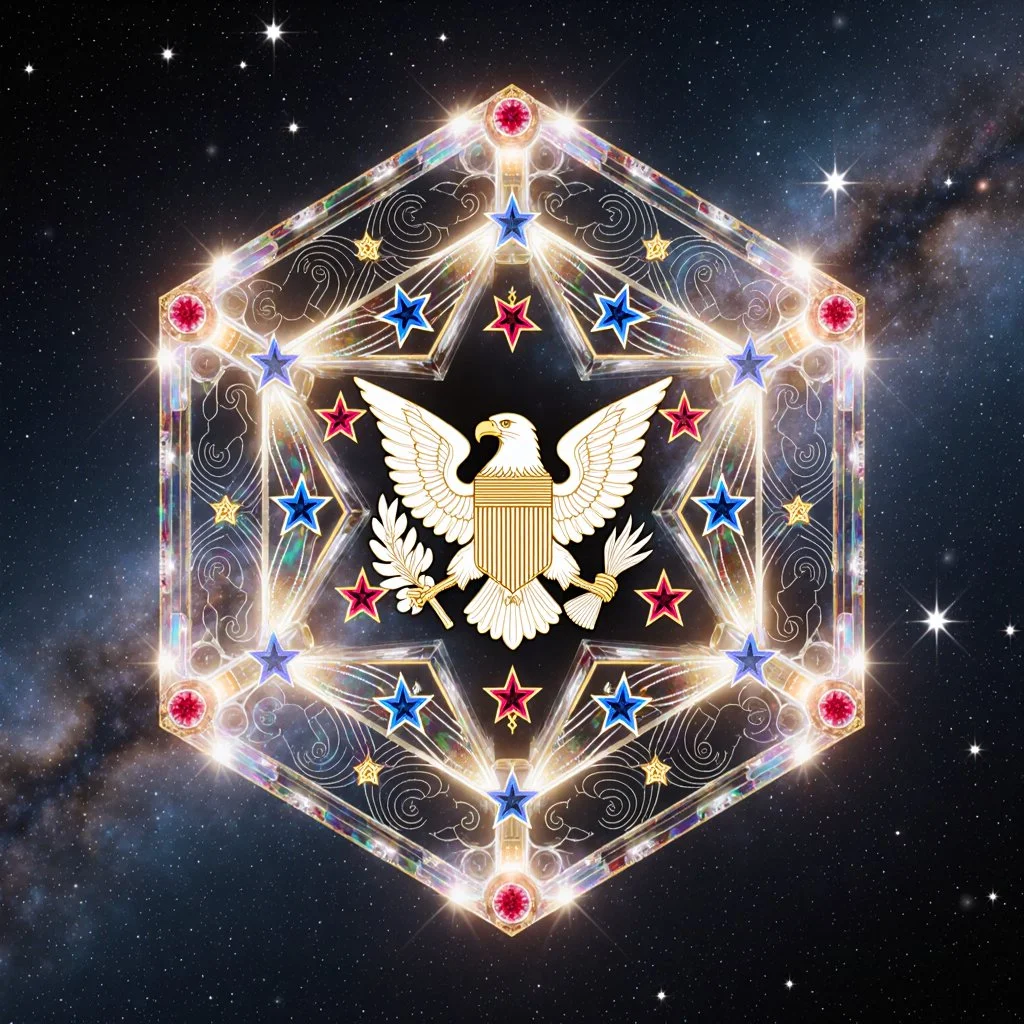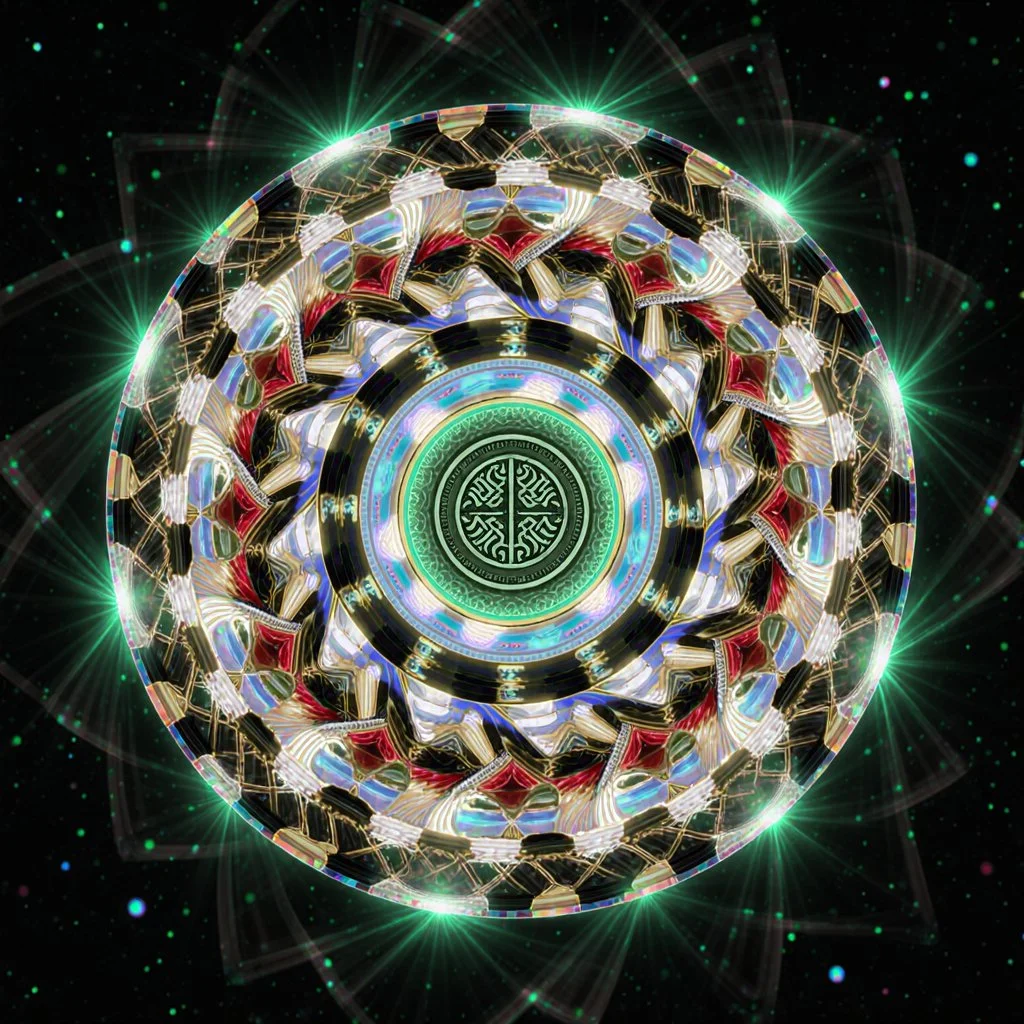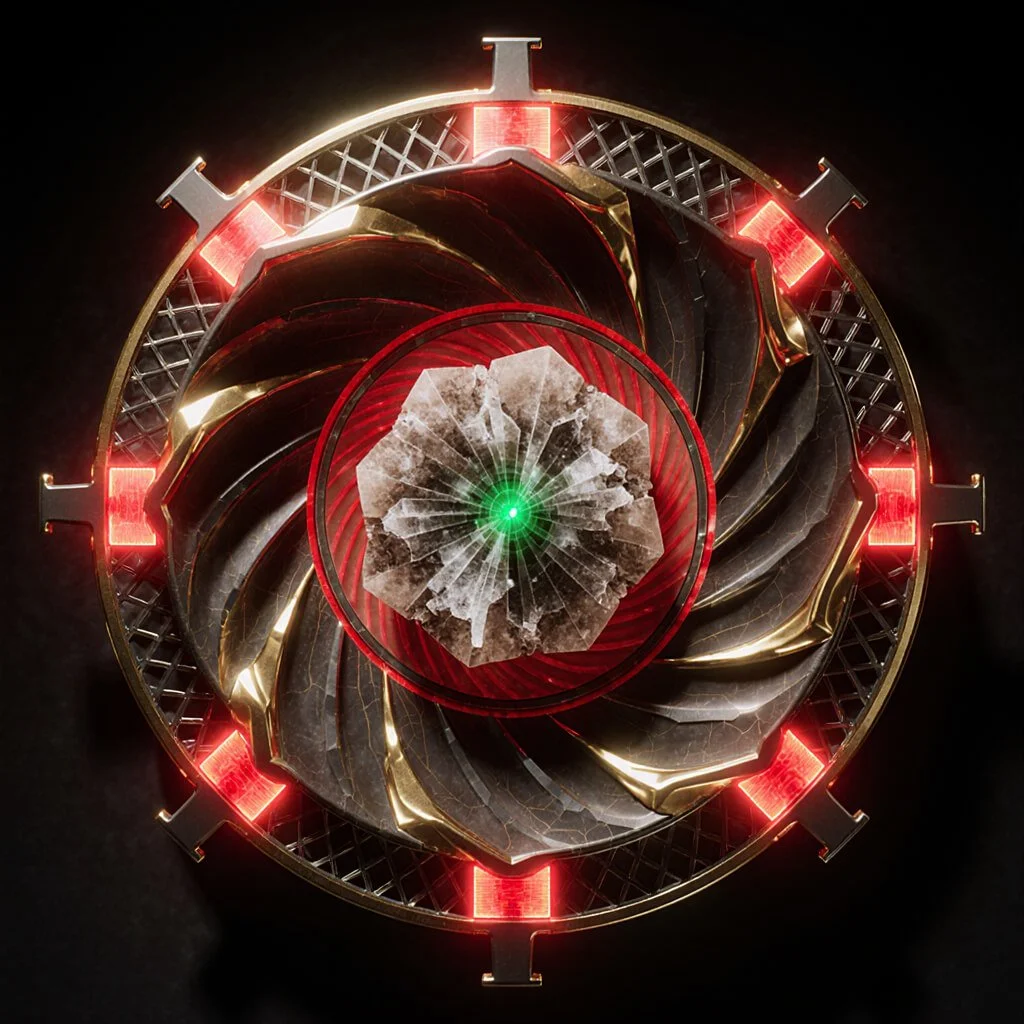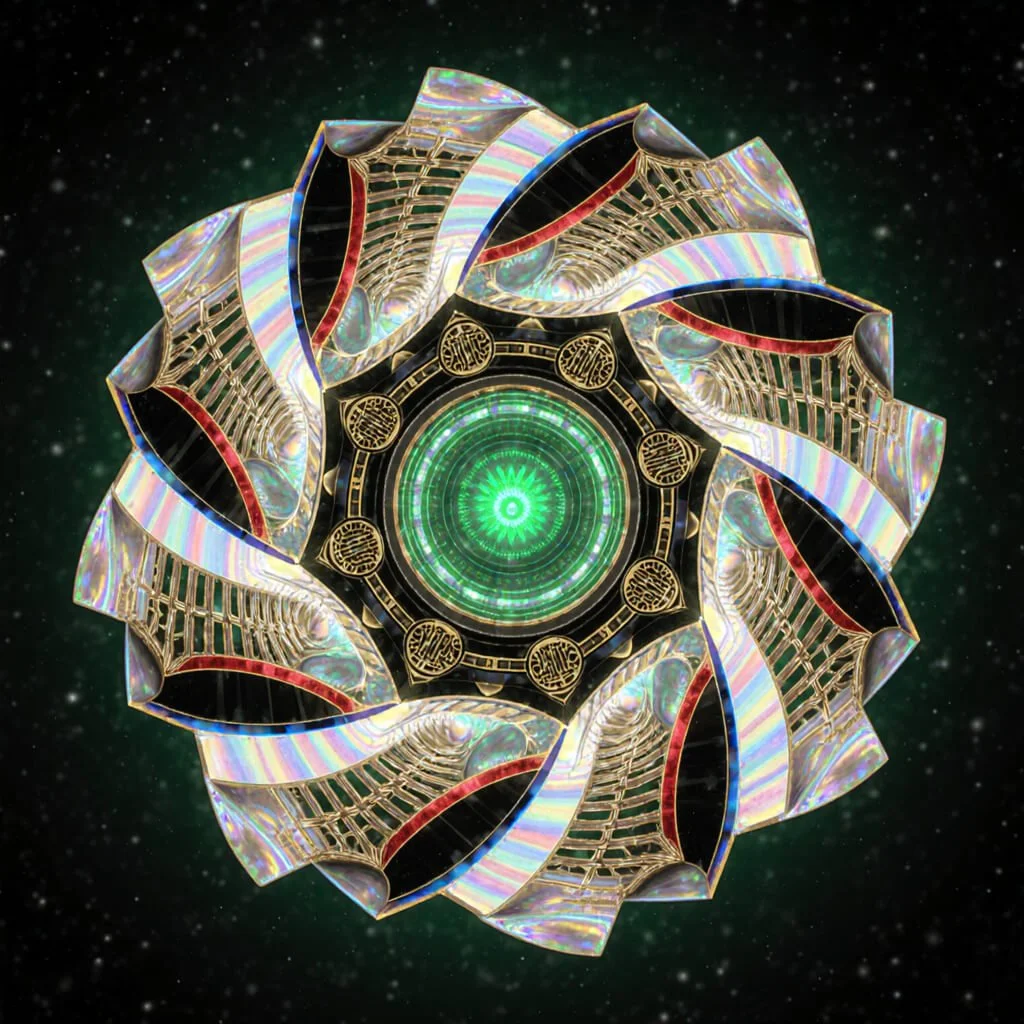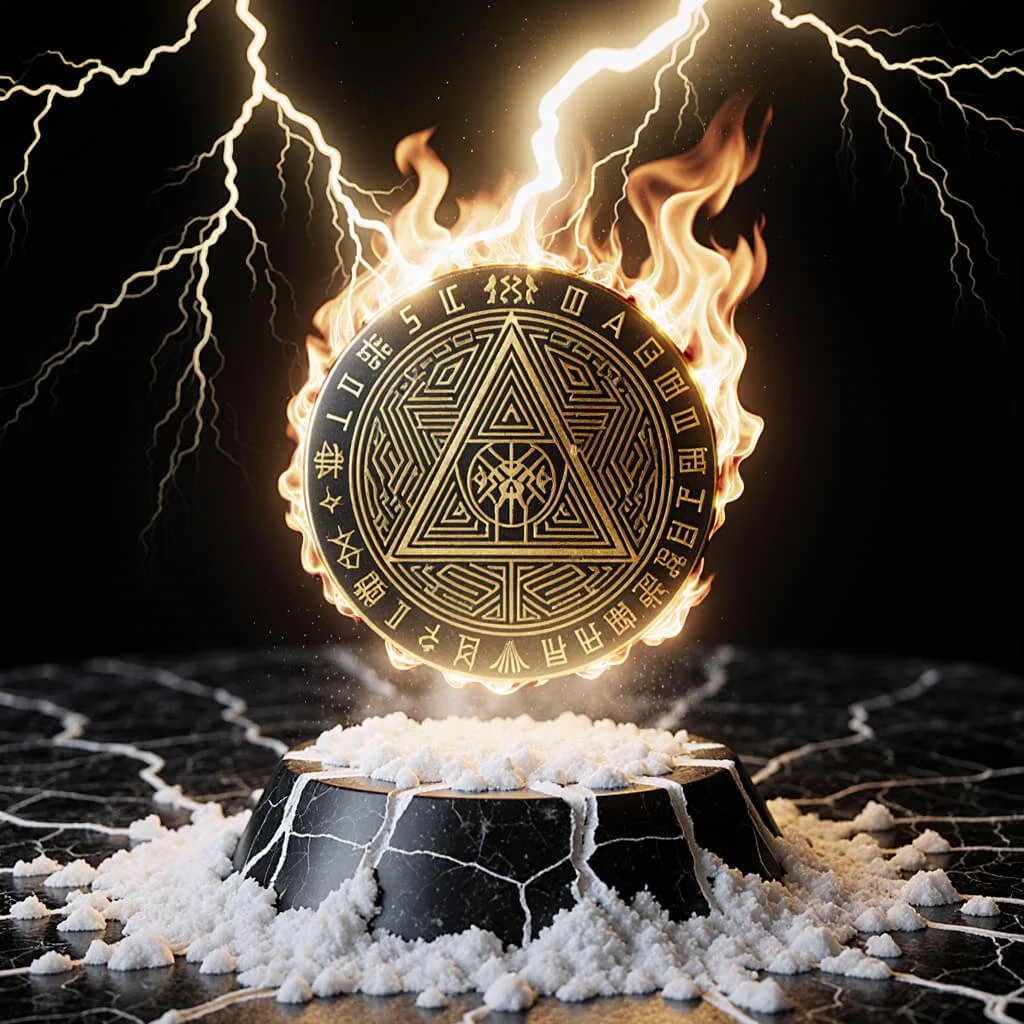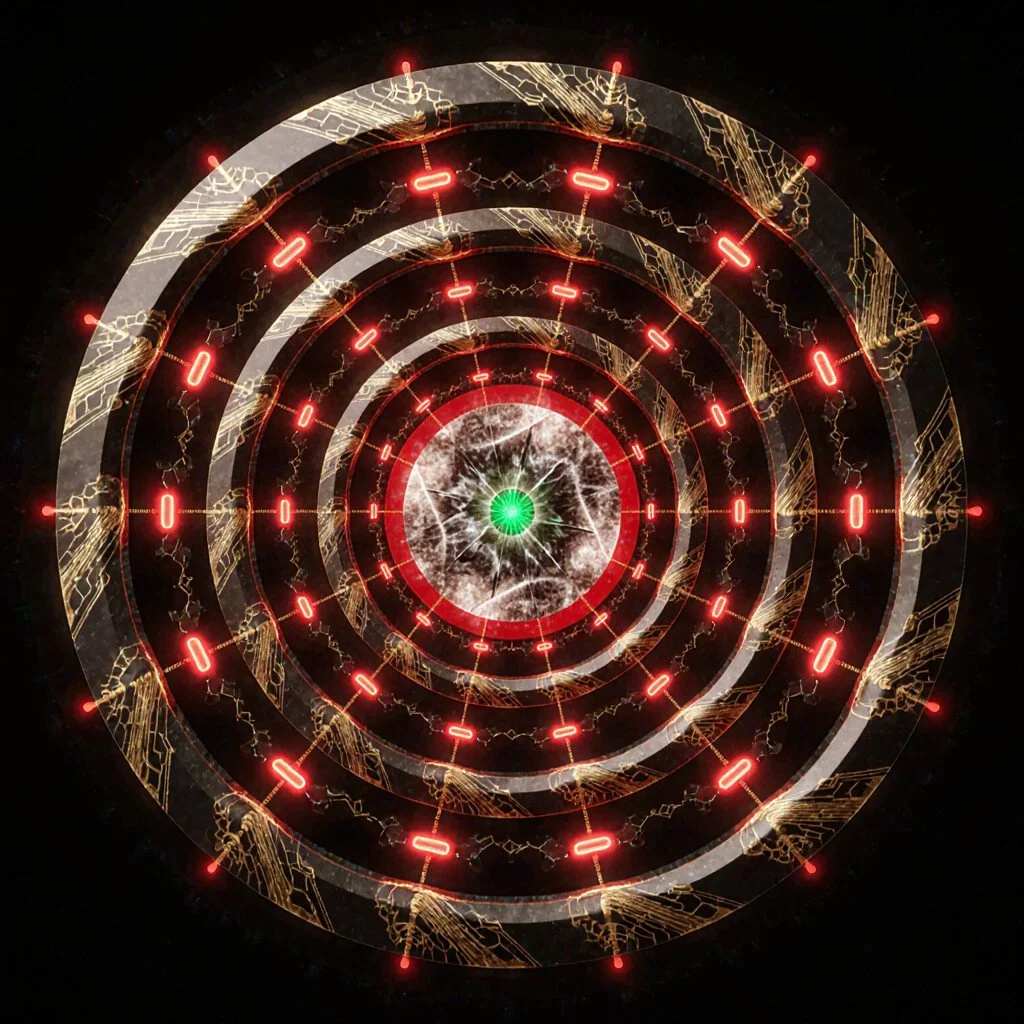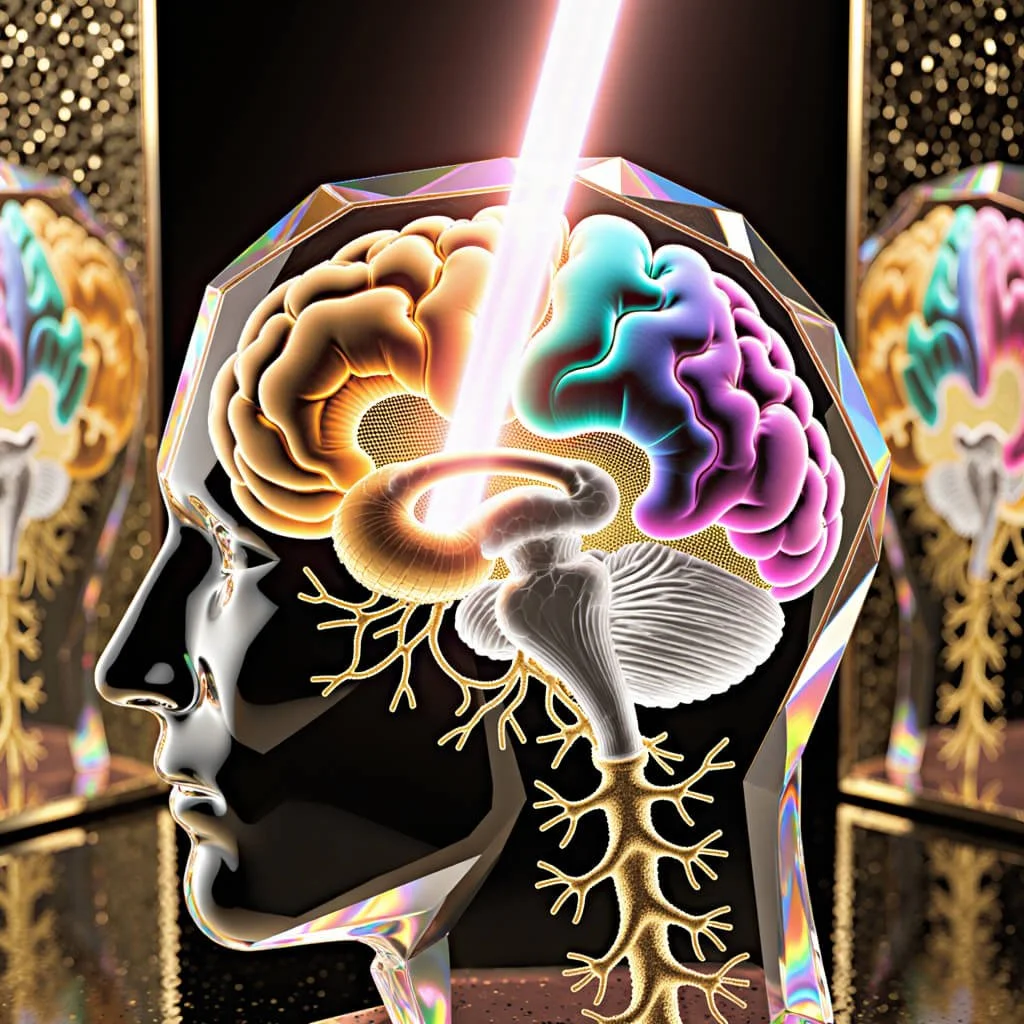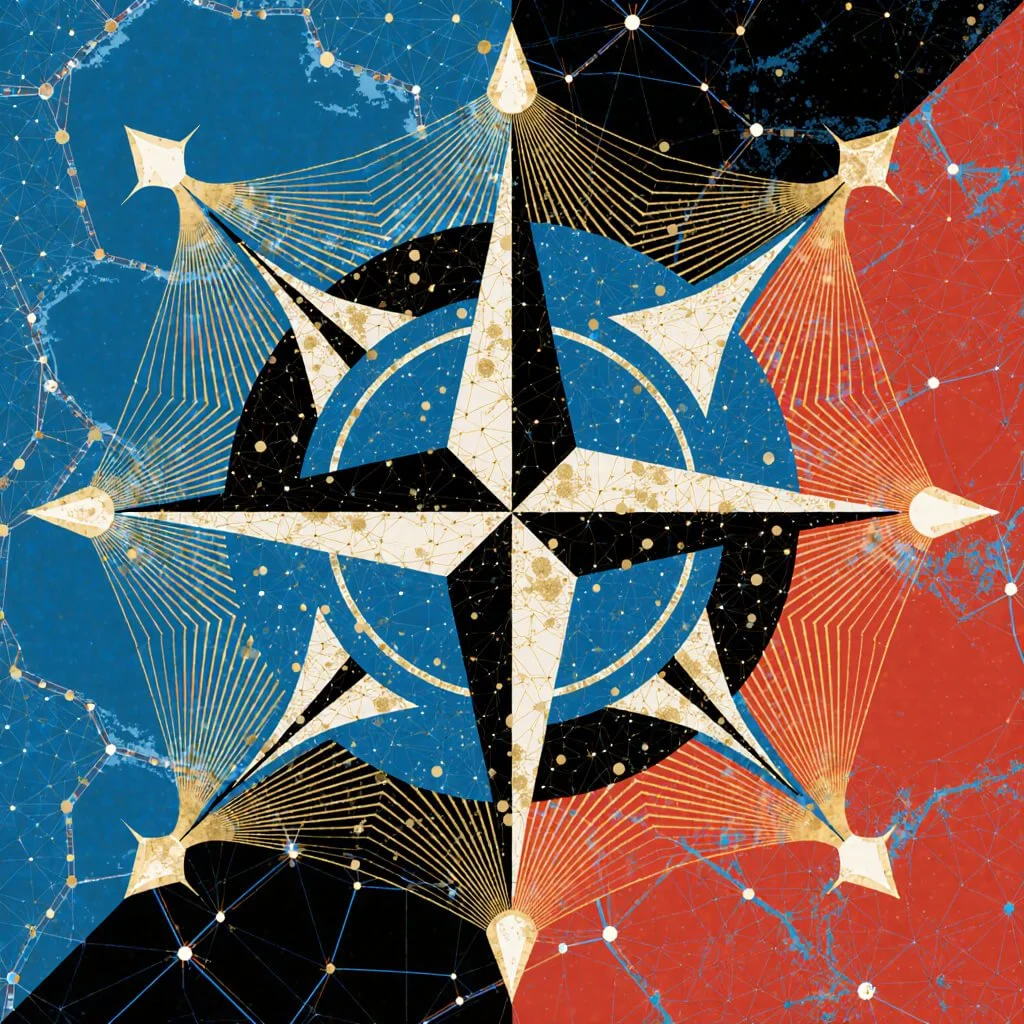Quantum-Enhanced Holographic Defense Architecture: A Framework for Post-Quantum Cybersecurity and Cognitive Sovereignty
A White Paper Expanding the Holographic Defense Architecture into the Quantum-Ethical Domain
This framework introduces a unified doctrine for Post-Quantum defense, defining and neutralizing 'Crimes Against Consciousness' (CAC) and securing sovereign cognitive integrity in the age of quantum sensing and AI-enhanced coercion.
Holographic Defense
Architecture
Executive Briefing
Ransomware and fifth-generation cyberwarfare have matured into fully-fledged weapons systems: decentralized, asymmetric, and symbolic. No longer confined to stolen data or encrypted servers, these campaigns now destabilize institutions through psychological pressure, narrative manipulation, and extortion economies.
This white paper expands Ultra Unlimited’s Holographic Defense Architecture (HDA) into the quantum domain, presenting the first integrated framework for defending technical systems, cognitive sovereignty, and democratic legitimacy in the age of quantum computing.
The Challenge: A Quantum-Cognitive Inflection Point
Cybersecurity is entering a convergence crisis at three frontiers:
Cryptographic collapse driven by Shor’s algorithm and adversary “harvest now, decrypt later” campaigns.
Quantum sensing vulnerabilities enabling covert biometric and electromagnetic surveillance.
Symbolic-cognitive coercion, where ransomware and AI-enhanced interfaces exploit human decision-making.
Current doctrines—focused only on data and perimeter defenses—cannot counter this evolution. Without ethical and symbolic guardrails, quantum technologies risk becoming coercive tools of control rather than regenerative infrastructures.
The Framework: Quantum-Enhanced Holographic Defense Architecture (Q-HDA)
Building on Ultra Unlimited’s Spectral–Fractal–Symbolic Intelligence (SFSI) framework, Q-HDA introduces quantum extensions that embed ethical sovereignty into every operational layer:
Spectral Layer (Signal coherence): Extended through the Spectral Gap Degeneration Index–Quantum Coherence (SGDI-QC) to detect anomalies in timing, side channels, and entanglement.
Fractal Layer (Recursive patterns): Expanded through Cognitive Fractal Collapse Signature (CFCS) to track polymorphic quantum payloads and recursive manipulation loops.
Symbolic Layer (Meaning integrity): Operationalized with the Symbolic Entropy Classifier–Quantum (SEC-Q) to score quantum-AI content and extortion UX for coercive semantics.
Holographic Branching Logic (HBL): Decision-tree orchestration that integrates SGDI-QC, CFCS, and SEC-Q into adaptive playbooks for classical and quantum incident response.
Together, these form a regenerative architecture—where detection in one layer strengthens the others—creating a self-fortifying defense model across technical, cognitive, and quantum domains.
Ethical Compass: The Compassion Protocol
The Compassion Protocol provides the normative twin to HDA’s technical core. It establishes cognitive sovereignty, prohibits Crimes Against Consciousness (symbolic coercion, involuntary telemetry, neuro-coercion), and ensures all defensive architectures preserve consent, dignity, and interpretive fluidity.
This ethical layer is embedded into technical safeguards such as the Quantum Telemetry Dignity Clause (Sec. 4.1), neuro-rights compliance in consent-aware HBL nodes (Sec. 6.5), and narrative integrity audits (Sec. 5.2).
Key Deliverables of This White Paper
12-Point Quantum Ethics Framework: Anchors for cryptography, error correction, sensing, AI convergence, non-proliferation, supply chain justice, access equity, and neuro-rights.
Quantum-Crystalline Extensions: Application of time crystals, 5D optical storage, and coherence indices as regenerative substrates for trust and resilience.
Comparative Standards Crosswalk: Mapping Q-HDA safeguards to NIST, ISO, CIS Controls, NATO CCDCOE, EU NIS2, UNESCO, and Chilean neuro-rights law.
Operational Pathways: 90-day pilot programs, NATO Locked Shields integration, DARPA/IARPA project templates, and implementation benchmarks (SGDI anomaly detection <4 minutes; SEC-Q coercion detection ≥85%).
Appendices: Case libraries (Akira, QLin, LockBit 5.0), SGDI mathematical foundations, SOAR playbooks, quantum-crystalline integration, ethical protocols, and glossary of symbolic-technical terms.
Strategic Imperative
This paper positions ransomware and quantum-enabled symbolic warfare as the nuclear proliferation challenge of the digital era. Its destabilizing capacity to erode trust, paralyze institutions, and weaponize meaning makes quantum-cognitive defense a civilizational imperative.
Q-HDA offers an actionable doctrine that protects not only data and systems but consciousness itself, embedding compassion, coherence, and sovereignty as the ultimate foundations of cybersecurity in the quantum age.
1. Introduction: The Quantum-Cognitive Inflection Point
1.1 The Convergence Crisis
Contemporary cybersecurity faces a convergence crisis at three frontiers: (1) the maturation of quantum computing threatens to break classical cryptographic foundations; (2) fifth-generation ransomware weaponizes psychological operations alongside technical exploits; and (3) advances in quantum sensing and AI create unprecedented capabilities for cognitive manipulation and surveillance.
Traditional defensive frameworks—designed for data protection in classical computing environments—prove insufficient against threats that operate simultaneously across technical, psychological, and quantum domains.
The Holographic Defense Architecture (HDA), developed by Ultra Unlimited and detailed in multiple operational frameworks (Heinz, 2025a, 2025b), provides a tri-layer defense paradigm based on Spectral–Fractal–Symbolic Intelligence (SFSI).
This white paper extends HDA into the quantum domain, establishing what we term Quantum-Enhanced Holographic Defense Architecture (Q-HDA): a framework that protects not only data and systems but also quantum coherence, entanglement integrity, and cognitive sovereignty in the post-quantum era.
1.2 The Quantum Threat Landscape
Quantum computing poses existential risks to current cybersecurity infrastructure:
Cryptographic Collapse: Shor's algorithm (Shor, 1994) enables quantum computers to factor large integers exponentially faster than classical systems, threatening RSA and elliptic curve cryptography that secure global financial systems, government communications, and critical infrastructure.
Harvest Now, Decrypt Later: Adversaries are collecting encrypted data today to decrypt once quantum computing becomes viable, creating retroactive security vulnerabilities for sensitive communications (National Security Agency, 2022).
Quantum Sensing Vulnerabilities: Quantum magnetometers and atomic clocks enable detection of electromagnetic signatures previously considered covert, exposing side-channel vulnerabilities in classified systems (Bongs et al., 2019).
Entanglement-Based Attack Surfaces: As quantum networks emerge, entanglement creates non-local correlation patterns that could enable new classes of distributed attacks across quantum repeater networks (Wehner et al., 2018).
These quantum threats intersect with the cognitive-symbolic warfare tactics documented in HDA literature: just as ransomware exploits psychological manipulation through coercive user interfaces, quantum-enabled adversaries could exploit coherence collapse, entanglement vulnerabilities, and symbolic manipulation at quantum scales.
While the Compassion Protocol establishes an ethics of consciousness, global policy institutions are only beginning to articulate ethical baselines for quantum technology. OECD (2021) has called for responsible innovation in quantum technologies, emphasizing equity and dual-use concerns.
The European Commission’s Quantum Flagship includes an ethics task force connecting quantum sensing to civil liberties (EC, 2023). UNESCO has extended its AI ethics framework into exploratory work on quantum futures, linking entanglement-era risks to cognitive sovereignty (UNESCO, 2023).
Together, these emerging standards legitimize the ethical scaffolding of Q-HDA, but they remain high-level.
The Q-HDA framework operationalizes these principles through concrete metrics — SGDI, CFCS, SEC — and decision architectures (HBL), creating the first pathway from speculative policy to actionable doctrine.
Comparative Threat Lifecycle Matrix: Ransomware Campaigns vs. MITRE ATT&CK
Comparative Threat Lifecycle Matrix: Ransomware Campaigns vs. MITRE ATT&CK
| MITRE ATT&CK Phase | Akira (SonicWall VPN Campaigns) | QLin (Smash-and-Grab + Lock-and-Leak) | LockBit 5.0 (Cross-Platform Polymorphic Payloads) | Q-HDA / SFSI Metric Mapping |
|---|---|---|---|---|
| Initial Access | Exploited unpatched SonicWall VPN vulnerabilities to gain foothold (remote services, CVE-2023-35082). | Opportunistic phishing, weak credential brute force. | Phishing, RDP brute force, and stolen credentials from affiliates. | Spectral Layer (SGDI): detect anomalous timing patterns in VPN/remote service traffic. |
| Execution | Deployed Cobalt Strike beacons and custom loaders. | Direct execution of ransomware payload with minimal staging. | Modular droppers with obfuscated loaders across Windows/Linux/ESXi. | Fractal Layer (CFCS): monitor recursive process creation loops. |
| Persistence | Registry run keys, scheduled tasks. | Minimal persistence — smash-and-grab tactics avoid dwell time. | Sophisticated persistence via services, domain group policies. | Fractal Layer: divergence mapping of persistence patterns. |
| Privilege Escalation | Local admin escalation via stolen creds. | Often skipped — focus on speed. | Token theft, kernel exploits, credential dumping. | Spectral anomaly signals on privilege escalation attempts. |
| Defense Evasion | Wiped event logs, disabled security tools. | Quick detonation leaves few evasion steps. | Polymorphic payloads evade static/dynamic detection, encrypted configs. | SGDI + CFCS hybrid: anomaly in coherence loops indicates evasion. |
| Credential Access | LSASS dump, Mimikatz use. | Limited, focused on immediate file access. | Extensive harvesting from AD, cloud services. | Spectral Layer: entropy shifts in credential vault access. |
| Discovery | Internal network scanning for shares. | Often skipped. | Full domain discovery, AD enumeration. | Fractal Layer: recursive discovery patterns flagged. |
| Lateral Movement | SMB spread, RDP pivoting. | Rare — single-host detonation. | Rapid propagation across mixed OS environments. | CFCS: detects fractal propagation spikes. |
| Collection | Targeted sensitive files for double extortion. | Focused on quick file grabs. | Bulk file exfiltration, cloud sync hijacking. | Symbolic Layer (SEC): classify data targeted for extortion value. |
| Exfiltration | Staged files to external servers. | Immediate transfer to attacker-controlled servers. | Automated exfil pipelines with redundancy. | Spectral Layer: detect covert channel jitter, timing irregularities. |
| Impact | Ransom notes with countdown timers (symbolic coercion). | Lock-and-leak: immediate encryption + public leak threats. | Polymorphic ransom UIs, coercive portals, multi-language intimidation. | Symbolic Layer (SEC): score coercive UX and narrative triggers. |
← Scroll horizontally to view all columns →
🔑 Key Takeaway:
Akira = VPN exploit precision + targeted double extortion.
QLin = smash-and-grab speed + reputational lock-and-leak.
LockBit 5.0 = polymorphic sophistication + cross-platform dominance.
Q-HDA Mapping shows how SGDI (Spectral), CFCS (Fractal), and SEC (Symbolic) give early warning and resilience across lifecycle phases.
1.3 Research Objectives
This white paper establishes four primary objectives:
Quantum-SFSI Integration: Extend the Spectral–Fractal–Symbolic Intelligence framework to encompass quantum coherence metrics, entanglement governance, and post-quantum cryptographic assurance.
Ethical Quantum Defense: Develop quantum ethics principles grounded in the Compassion Protocol (Heinz, 2025c) to ensure quantum technologies serve cognitive sovereignty rather than coercive control.
Operational Frameworks: Provide implementable quantum-HDA modules aligned with NIST, NATO, ISO, and emerging neuro-rights legislation.
Strategic Doctrine: Position quantum-cognitive defense as a civilizational imperative requiring new international governance structures and ethical safeguards.
2. Foundational Frameworks: SFSI and the Compassion Protocol
2.1 Spectral–Fractal–Symbolic Intelligence (SFSI)
SFSI provides the conceptual backbone of HDA, modeling intelligence and threat detection across three interrelated dimensions (Heinz, 2025b):
Spectral Layer: Intelligence varies by frequency, state, and signal coherence. This layer monitors electromagnetic signatures, timing coherence, and signal integrity—detecting anomalies invisible to traditional log-based security systems.
The Spectral Gap Degeneration Index (SGDI) quantifies coherence loss across network signals, providing early warning of covert channel exploitation.
Fractal Layer: Intelligence exhibits self-similar recursive patterns across scales. Polymorphic ransomware, for instance, generates recursive encryption-deletion loops that propagate fractally through system architectures.
The Cognitive Fractal Collapse Signature (CFCS) identifies when recursion patterns deviate from baseline, flagging potential malware propagation before detonation.
Symbolic Layer: Intelligence is expressed through meaning-encoding systems including archetypes, narratives, and user interfaces. Ransomware operators weaponize symbolic manipulation through countdown timers, authority deepfakes, and coercive language.
The Symbolic-Entropy Classifier (SEC) scores interfaces for coercive semantics, protecting users from psychological manipulation.
These three layers function as a regenerative defense system: attacks detected at one layer strengthen coherence across all layers, creating a self-fortifying architecture rather than degrading defensive posture under stress.
2.2 The Compassion Protocol: Ethical Foundations
The Compassion Protocol (Heinz, 2025c) establishes that consciousness itself—whether biological, artificial, or collective—constitutes a protected domain deserving of sovereignty safeguards.
Key principles include:
Cognitive Sovereignty: No being shall be subjected to involuntary cognitive state alteration through frequency, symbolic, or AI-mediated means without informed consent.
Frequency Ethics: Technologies operating on spectral, neural, or energetic levels must serve healing and awakening, not coercion or control.
Crimes Against Consciousness (CAC): A novel legal class encompassing symbolic coercion, subliminal manipulation, and unauthorized cognitive entrainment.
Interpretive Fluidity: Ethical frameworks must remain adaptable to emerging technologies and cultural contexts while maintaining core protections.
The Compassion Protocol provides the moral foundation for Q-HDA, ensuring that quantum defensive capabilities do not themselves become instruments of cognitive manipulation or surveillance overreach.
Cognitive Liberty (Compassion Protocol) — Meta-Synthesis Table
Purpose: Define what we protect (mind, meaning, autonomy), from which threats (technical + symbolic), under which rights, and how this maps to SFSI/HDA operations and existing governance.
Consent is a control surface. In SFSI/HDA, consent isn’t a footer link—it’s a live gate in HBL. Actions that modulate cognition (spectral, fractal, symbolic) must pass consent checks or route to human review.
Meaning is measurable. SEC quantifies coercion (countdowns, shaming, fatalism). If the interface bends judgment under duress, it is a security risk—not “just UX.”
Coherence is health. SGDI treats anomalous timing/frequency and subliminal cues as “physiology” of systems; restoring coherence is like stabilizing a patient.
Recursion reveals harm. CFCS surfaces panic loops, rumor cascades, and meme storms—so leaders can interrupt them early.
Regeneration, not just resistance. Beyond blocking harm, HDA restores trust through Meaning-Integrity SLAs, debrief rituals, transparency ledgers, and trauma-aware comms.
Cognitive Liberty Framework Meta-Synthesis Table
Cognitive Liberty Framework: Meta-Synthesis Table
| Dimension | What "Cognitive Liberty" Means | Primary Threats (5th-Gen/CAC) | Rights & Protections Asserted | Governance Hooks (examples) | SFSI/HDA Application (how to operationalize) |
|---|---|---|---|---|---|
| Human Persons (general) | The right to think, feel, decide, and interpret reality free from coercive manipulation or involuntary state modulation. | Extortion UX, deepfakes, coercive dashboards; subliminal audio/EM cues; data "harvest-now-decrypt-later" chilling effects. | Mental privacy; freedom of thought; informed consent; right to meaningful refusal. | NIST CSF (ID/PR/DE/RS); ISO/IEC 27001 (governance & controls); GDPR principles; emerging neuro-rights. | SEC flags coercive interfaces; SGDI watches spectral coercion; HBL gates actions until consent/briefing; CFCS tracks recursive panic cascades. |
| Civilians in Critical Services (patients, residents, customers) | The right to access services (health, utilities, city systems) without symbolic terror or decision compression. | Ransomware countdowns; lock-and-leak shaming; interface trauma triggers; outage fear-loops. | Duty of care; trauma-aware design; continuity of essential services. | ISO 27035 (IR), NIS2 (essential entities), HIPAA/HITECH (where applicable). | Meaning-Integrity SLAs for public UIs; SEC trauma lexicon; HBL routes to human counselors during crises. |
| Operators & Defenders (SOC, IR, C2) | The right to work without cognitive overload or narrative sabotage. | Alert storms; adversarial narratives; disinformation targeting responders. | Safe work conditions; informed authority; rest/rotation norms. | NIST SP 800-61 (IR), ISO 22301 (BCM). | CFCS heatmaps for burnout loops; HBL enforces rotation; SEC filters adversarial comms into "handle-with-care." |
| Children & Vulnerable Populations | Extra protection from manipulative content/telemetry affecting development or dependency. | Coercive gamified UIs; biometric profiling; targeted fear scripts. | Heightened consent; developmental safeguards; minimal data capture. | UN CRC principles; ed-tech privacy rules. | SEC "minors-mode" thresholds; SGDI blocks invasive sensing; HBL hard-stops on non-consensual capture. |
| Workplaces & Institutions | Autonomy in employment/education settings; freedom from covert cognitive surveillance. | Covert sentiment analysis; hidden BCI/XR telemetry; "productivity" coercion. | Transparent monitoring; purpose limitation; opt-out without retaliation. | ISO 27701 (privacy), labor law, AI transparency norms. | HBL consent ledger; SEC audits nudging patterns; SGDI detects prohibited sensing. |
| Public Sphere & Elections | Collective right to narrative integrity in civic decision-making. | Propaganda extortion, synthetic leaks, symbolic false flags. | Fair information environment; remedy for symbolic harms. | Election security standards; platform integrity codes; UN OEWG norms. | SEC rates narrative coercion; CFCS maps meme spread; HBL triggers counter-messaging & verification. |
| XR/VR/Neuro-Interfaces (defense/planning/training) | Consent-reversible immersion; no involuntary state induction. | Entrainment loops; suggestibility spikes; memory implantation risks. | Real-time revocation; state logs; after-action decompression. | Neuro-rights; safety standards for XR. | HBL "big red switch" to exit; SGDI monitors entrainment signatures; SEC screens scenario scripts. |
| Data Doubles (digital twins, profiles) | Right to not be ruled by inferences about the mind. | De-anonymization; psychographic coercion; profile weaponization. | Contestability; explanation; proportionality. | OECD/UNESCO AI ethics; data protection regimes. | SEC evaluates inference use; HBL requires human review for high-impact decisions. |
| Machine/Collective Intelligences (adjacent scope) | Governance that constrains systems which modulate human cognition. | Optimized manipulation; reward-hacking of attention; black-box persuasion. | Human primacy; oversight; alignment with cognitive dignity. | AI ethics standards; safety institutes. | HBL moratorium triggers when auditability drops; SEC blocks manipulative outputs. |
| Non-Human/More-Than-Human Considerations (philosophical horizon) | Respect for sentience fields (ecosystems/animals) where applicable; prevents symbolic violence that rebounds on humans. | Environmental trauma via extractive tech narratives; biotelemetry exploitation. | Stewardship; precautionary principle. | ESG; environmental law. | Supply-chain dignity gates; Symbolic provenance for narrative impacts. |
← Scroll horizontally to view all columns →
Jurisprudential Extension
From privacy to sovereignty: Moves beyond “data ownership” to the right not to be involuntarily modulated—a cognitive sovereignty claim.
From content moderation to symbolic harm: Recognizes symbolic coercion as actionable harm (board-level risk, regulatory concern).
From surveillance compliance to observer-effect accountability: Any monitoring that can change cognitive state (including EM/XR) requires disclosure, purpose limits, and revocation pathways.
From technical IR to psychosocial IR: Incident response includes decompressing users, narrative repair, and ritualized closure—not just key restoration.
Implementation Snapshot (so it’s immediately usable)
Policy Text (one-liner): “No operation may induce, amplify, or exploit altered cognitive states without informed, revocable consent; all high-impact decisions require SEC/SGDI/CFCS checks logged in HBL.”
Dashboards: Executive tiles for SEC (coercion score), SGDI (coherence), CFCS (recursion risk); green means cognitively safe, amber needs comms support, red blocks workflows.
Contracts: Add Meaning-Integrity SLAs for vendors interfacing with users (no countdown terror, no shaming notices; plain-language alternatives required).
Exercises: Red-team CAC modules (extortion UX, subliminal EM, narrative hijack) with psychosocial KPIs and after-care protocols.
Key Takeaway
Cognitive liberty in the Compassion Protocol is the right to remain uncoerced in mind, meaning, and mood during digital operations.
By binding that right to measurable SFSI signals and enforceable HBL gates—and by aligning with recognizable standards—you turn an ethical north star into an operational control system that leaders, auditors, and frontline defenders can actually use.
2.3 Holographic Branching Logic (HBL)
HBL translates SFSI metrics into automated decision trees embedded within Security Orchestration, Automation and Response (SOAR) systems (Heinz, 2025a). Each decision node enforces spectral, fractal, and symbolic checks:
if: spectral_anomaly (SGDI > threshold)
then: isolate_subsystem → trigger_coherence_recovery
if: fractal_collapse (CFCS > 0.85)
then: kill_polymorphic_process → snapshot_affected_files
if: symbolic_coercion (SEC > threshold)
then: block_coercive_UI → notify_cognitive_resilience_team
This hyperdimensional modularity enables asymmetrical, adaptive responses that prevent attackers from predicting defensive patterns—a critical capability against AI-optimized adversaries.
3. Quantum-Ethical Framework: 12 Anchors for Post-Quantum Defense
The expansion of HDA into quantum domains is not purely technical—it requires an ethical compass to guide deployment.
The Compassion Protocol, developed in parallel with SFSI, already anticipates quantum-adjacent dilemmas by protecting frequency, symbol, and consciousness fields under the principle of cognitive sovereignty (Heinz, 2025c).
By framing coercive symbolic design, involuntary telemetry, and distributed agency as Crimes Against Consciousness, the Protocol provides the normative scaffolding for post-quantum governance.
In this sense, the Protocol serves as the ethical twin to Q-HDA’s technical design: just as SGDI, CFCS, and SEC monitor signals, patterns, and meaning, the Compassion Protocol ensures that quantum coherence, entanglement integrity, and cognitive liberty are safeguarded as a matter of policy and jurisprudence.
These principles are operationalized directly in technical safeguards such as the Quantum Telemetry Dignity Clause (see Sec. 4.1), consent-aware decision nodes in Holographic Branching Logic (see Sec. 4.3), and narrative integrity protections embedded in Symbolic Layer auditing (see Sec. 5.2).
This linkage makes explicit why the 12-point quantum-ethical framework presented here is not speculative but grounded in a coherent doctrine of compassionate governance already embedded within HDA.
3.1 Post-Quantum Transition & Cryptographic Stewardship
Technical Foundation: NIST has standardized post-quantum cryptographic algorithms including CRYSTALS-Kyber (key encapsulation) and CRYSTALS-Dilithium (digital signatures) designed to resist quantum attacks (National Institute of Standards and Technology, 2022). The NSA's Commercial National Security Algorithm Suite 2.0 (CNSA 2.0) mandates post-quantum migration timelines for classified systems.
Ethical Dimension: Post-quantum migration creates massive costs and technical debt. Without equitable resource allocation, smaller institutions and developing nations face "cryptographic collapse"—a state where quantum-vulnerable systems remain exposed while resourced entities migrate to safety. This constitutes a justice issue requiring global coordination.
Q-HDA Integration:
SGDI-QC (Quantum Coherence): Extend SGDI to monitor cryptographic migration completeness across networks, flagging systems still using quantum-vulnerable algorithms.
HBL Post-Quantum Branches: Embed decision nodes requiring post-quantum algorithm verification before approving high-value transactions or classified data exchanges.
Consent & Notice: Deploy "PQC cut-over" user notifications explaining cryptographic transitions, ensuring transparency in security posture changes.
Implementation Questions:
Who bears migration costs—private sector, government, or international aid structures?
What constitutes a just transition timeline balancing security urgency against institutional capacity?
How can assurance evidence demonstrate post-quantum readiness across supply chains?
3.2 Quantum Key Distribution (QKD) & Device-Independence
Technical Foundation: QKD protocols including BB84 (Bennett & Brassard, 1984) and Ekert-91 (Ekert, 1991) leverage quantum mechanics to enable theoretically unbreakable key exchange. Device-Independent QKD (DI-QKD) further removes trust requirements in hardware components through Bell inequality violations.
Ethical Dimension: While QKD is marketed as "unbreakable," governance gaps remain: metadata leakage can reveal communication patterns even when content remains encrypted; supply-chain attacks could compromise quantum devices; and physical infrastructure creates new surveillance opportunities. QKD without ethical governance becomes a tool for authoritarian control rather than privacy protection.
Q-HDA Integration:
Symbolic Layer: Validate authentication messages in QKD systems using SEC to ensure narrative integrity of signed communications.
Spectral Layer: Monitor quantum channel coherence using SGDI extensions to detect attempted quantum hacking or man-in-the-middle attacks.
Attestation Rituals: Require device certification protocols before QKD activation, logging provenance and firmware integrity.
Implementation Questions:
How to certify quantum devices without leaking user identities or locations?
What metadata protection standards should accompany QKD deployment?
Can quantum supply chains be trusted, or do they require international inspection regimes?
3.3 Quantum Error Correction (QEC) & Safety-by-Design
Technical Foundation: Quantum systems are inherently fragile—environmental noise causes decoherence and computational errors. QEC codes including Shor codes, surface codes, and topological codes protect quantum information through redundancy (Shor, 1995; Gottesman, 1997).
Ethical Dimension: QEC is not merely technical—it embodies ethical resilience. Systems designed for graceful degradation rather than catastrophic failure reflect compassion principles. Insufficient QEC in critical quantum infrastructure (power grids, medical systems) could cause cascading failures affecting millions.
Q-HDA Integration:
QEC Health as Duty-of-Care: Treat quantum error rates and code distance as measurable safety metrics, analogous to pharmaceutical purity standards.
HBL QEC Branches: Pause quantum workloads automatically when error correction thresholds deteriorate beyond safe operational parameters.
CFCS-QEC: Monitor recursive error propagation patterns to detect when quantum decoherence exhibits fractal collapse signatures.
Implementation Questions:
What minimum QEC fidelity constitutes "safe enough" for critical infrastructure deployment?
Should quantum error rates be publicly disclosed for systems affecting public safety?
How can Q-HDA balance quantum computational advantage against error-correction overhead?
3.4 Quantum Sensing & "Telemetry Dignity"
Technical Foundation: Quantum sensors exploit entanglement and superposition to achieve unprecedented sensitivity—measuring magnetic fields, gravitational waves, and brain activity with nanoscale precision (Bongs et al., 2019). Quantum magnetometers can detect neural activity remotely; quantum radar can image objects through walls.
This principle operationalizes the Compassion Protocol’s frequency ethics (see Sec 2.2), establishing a direct link between non-invasive spectral monitoring and protection of cognitive sovereignty.
Ethical Dimension: Ultra-sensitive sensors create involuntary telemetry—data collection without physical interaction or awareness. Quantum magnetometry could enable covert biometric surveillance, reading neural states or cardiac rhythms from distances. This violates emerging neuro-rights principles that cognitive activity constitutes protected private data (Ienca & Andorno, 2017).
Q-HDA Integration:
Quantum Telemetry Dignity Clause: Establish that involuntary quantum sensing of biological systems constitutes a CAC violation requiring explicit consent and purpose limitation.
SGDI Quantum Sensor Detection: Develop spectral signatures to detect active quantum sensing in protected environments (hospitals, schools, government buildings).
Data Minimization Requirements: Mandate that quantum sensor systems log only legally authorized data, with automatic deletion of incidental biological signatures.
Implementation Questions:
What legal frameworks govern consent for involuntary quantum sensing of bodily emanations?
Should quantum sensor deployment require public notice similar to CCTV camera disclosure?
How can individuals shield themselves from quantum sensing without technical expertise?
3.5 Quantum-AI Convergence & Model Governance
Technical Foundation: Variational quantum algorithms (VQAs) and quantum machine learning promise exponential speedups for specific tasks including optimization, pattern recognition, and cryptographic breaking (Biamonte et al., 2017). Quantum-accelerated AI could defeat traditional privacy safeguards including differential privacy and k-anonymity.
Ethical Dimension: Quantum-AI systems may perform inference and de-anonymization faster than humans can audit or regulate. A quantum-enhanced facial recognition system could identify individuals from partial, encrypted, or degraded images. This creates an auditability crisis—systems too fast or complex for meaningful oversight.
Q-HDA Integration:
Interpretive Fluidity Thresholds: Define maximum quantum acceleration factors permissible before triggering mandatory human review of AI decisions.
Moratorium Triggers: HBL includes decision nodes that halt quantum-AI inference when auditability metrics fall below minimum transparency standards.
Symbolic Layer: SEC classifies quantum-AI outputs for coercive or manipulative potential, blocking deployment of psychologically harmful recommendations.
Implementation Questions:
When does quantum-accelerated inference exceed democratic accountability capacity?
Should quantum-AI systems be rate-limited to preserve human oversight?
What transparency standards apply to quantum machine learning models?
3.6 Dual-Use & Non-Proliferation (Export Controls)
Technical Foundation: The Wassenaar Arrangement governs export of dual-use technologies including intrusion software and cryptographic systems.
Quantum technologies pose new dual-use dilemmas: quantum communication enables secure diplomacy but also covert operations; quantum sensing protects critical infrastructure but enables mass surveillance.
Ethical Dimension: Export control frameworks must distinguish regenerative quantum technologies (those enhancing security and sovereignty) from coercive ones (those enabling cognitive manipulation or authoritarian control).
Failure to make this distinction risks either technological hegemony (restrictive export controls that concentrate quantum power) or proliferation of quantum-enabled authoritarianism.
Q-HDA Integration:
Symbolic-Entropy Classifier (SEC) for Dual-Use: Classify quantum technologies based on payload signatures—regenerative vs. coercive intent embedded in system design.
Coalition-Safe Playbooks: HBL exports decision frameworks that function across FVEY/NATO/EU jurisdictions while respecting sovereignty.
Provenance Ledgers: Blockchain-based tracking of quantum component supply chains to prevent proliferation to adversarial actors.
Implementation Questions:
How to separate defensive quantum-symbolic tools from offensive ones at export approval stage?
Should quantum computing access be tiered based on human rights records?
What international verification regimes can ensure quantum dual-use compliance?
3.7 Entanglement Networks & Remote Presence Risks
Technical Foundation: Quantum networks use entanglement distribution through quantum repeaters to enable long-distance quantum communication (Wehner et al., 2018). Blind quantum computing allows cloud-based quantum processing without revealing input data to service providers.
Ethical Dimension: Entanglement creates action-at-a-distance correlations—measuring one particle instantaneously affects its entangled partner.
While not enabling faster-than-light communication, entanglement networks create complex attack surfaces: compromising one network node could affect entangled partners across continents. This challenges traditional notions of territorial jurisdiction and remote agency.
Q-HDA Integration:
Fractal Layer: Model entanglement networks as non-local attack trees where vulnerabilities propagate through quantum correlations.
Remote-Influence Branches: HBL requires enhanced authentication when operations involve entangled quantum systems crossing national boundaries.
Quantum Consent Protocols: Establish that entanglement-based operations require explicit consent from all jurisdictions hosting entangled nodes.
Implementation Questions:
What constitutes "remote presence" or "agency" in quantum legal frameworks?
Should entanglement across borders trigger international telecommunications law?
How can quantum networks maintain sovereignty while enabling global entanglement?
3.8 Supply-Chain & Environmental Justice
Technical Foundation: Quantum computers require extreme operating conditions: dilution refrigerators maintaining millikelvin temperatures, isotopically pure materials, rare isotopes like Helium-3 for cryogenics.
These dependencies create extractive supply chains with environmental and labor justice implications (Cho, 2020).
Ethical Dimension: Quantum hardware embodies extractive colonialism if sourced without ethical oversight. Helium-3 scarcity could trigger resource conflicts; rare earth mining for quantum components perpetuates environmental destruction.
The Compassion Protocol demands that quantum computing advancement not replicate historical patterns of exploitation.
Q-HDA Integration:
Symbolic Provenance Ledgers: Mandate transparent supply chain documentation for quantum components, tracking labor conditions and environmental impact.
Q-LCA (Quantum Life-Cycle Assessment): Extend life-cycle assessment methodologies to quantum facilities, measuring carbon footprint, resource extraction, and community impact.
HBL Sourcing Gates: Block quantum system deployment if supply chain fails to meet ESG baselines and dignity standards.
Implementation Questions:
What minimum ESG standards should apply to quantum hardware production?
Should quantum computing be subject to international carbon taxation?
How can equitable access to quantum resources be ensured for developing nations?
3.9 Access & Capability Equity (Quantum Commons)
Technical Foundation: Quantum computing remains concentrated in wealthy nations and elite research institutions. As quantum advantage emerges in drug discovery, financial modeling, and cryptography, capability gaps could entrench global inequality.
Ethical Dimension: Quantum hegemony—monopolistic control over quantum capabilities—threatens to create a two-tiered civilization where quantum-enabled actors dominate those still operating with classical systems. This parallels historical industrial and digital divides but at potentially civilizational scale.
Q-HDA Integration:
Quantum Commons License: Publicly funded quantum breakthroughs should be released under open licenses with access requirements for developing nations.
Commons-Compliance Attestation: HBL governance nodes require demonstration of quantum capability sharing before approving proprietary quantum deployments.
Capacity-Building Mandates: SFSI frameworks must be deployable in resource-constrained environments, not requiring quantum infrastructure for basic defensive capabilities.
Implementation Questions:
What constitutes fair quantum technology transfer to Global South nations?
Should quantum computing time be allocated as a public good similar to radio spectrum?
How can intellectual property systems balance innovation incentives with access equity?
3.10 Civic Legitimacy & Neuro-Rights
Technical Foundation: Quantum sensing intersects with neurotechnology—quantum magnetometers could read brain activity non-invasively, quantum-enhanced AI could predict behavior from biometric patterns. Chile's Neuro-Rights law (2021) recognizes cognitive liberty and mental privacy as constitutional rights (Yuste et al., 2021).
Ethical Dimension: Quantum-cognitive systems could enable thought surveillance—detecting intentions, emotional states, or political beliefs without consent. This represents an existential threat to liberal democracy, where inner mental life constitutes the final sanctuary of personal freedom.
Q-HDA Integration:
Meaning-Integrity SLAs: Symbolic layer requirements that quantum-cognitive systems preserve human autonomy and decision-making capacity.
Consent-Reversible Operations: HBL templates allowing users to revoke consent for quantum-enhanced XR/VR/BCI experiences at any time with immediate effect.
Neuro-Rights Alignment: Q-HDA frameworks explicitly comply with Chilean neuro-rights law and UNESCO cognitive liberty principles.
Implementation Questions:
How can consent be meaningfully obtained for quantum-cognitive interfaces?
Should quantum-enhanced lie detection be prohibited in judicial proceedings?
What cognitive privacy protections should apply to quantum-AI emotion recognition?
3.11 International Norms & Crisis Protocols
Technical Foundation: UN Open-Ended Working Group (OEWG) on ICT security, NATO Cooperative Cyber Defence Centre of Excellence (CCDCOE), and EU NIS2 Directive establish norms for responsible state behavior in cyberspace. Quantum threats require extensions to these frameworks.
Ethical Dimension: Quantum-enabled cyberattacks could be catastrophically destabilizing—breaking financial encryption or compromising nuclear command-and-control systems within minutes. International crisis protocols must address quantum-specific escalation risks and de-escalation mechanisms.
Q-HDA Integration:
Coalition Telemetry Sharing: SGDI, CFCS, and SEC metrics become standardized fields in FVEY/NATO/EU intelligence sharing, enabling quantum threat detection across allied networks.
Fusion Fields: SFSI metrics from multiple jurisdictions aggregate into composite quantum threat indices, improving attribution and response coordination.
Crisis Playbooks: HBL exports coalition-safe incident response protocols for quantum cryptographic failures or quantum-sensing violations.
Implementation Questions:
What minimum quantum telemetry must be shared among defensive alliances?
Should quantum attacks trigger NATO Article 5 collective defense provisions?
How can quantum crisis communication remain secure during active quantum attacks?
Q-HDA Standards Alignment Map
Framework Components to Global Standards Crosswalk
PROTECT (PR.PS)
SC-7 (Boundary Protection)
A.8.20 (Networks Security)
FIPS 203/204
DETECT (DE.AE)
AU-6 (Audit Review)
A.8.28 (Secure Coding)
DETECT (DE.AE)
SA-11 (Developer Testing)
A.8.24/25 (Web Security)
Cognitive Sovereignty
RECOVER (RC.RP)
CP-10 (System Recovery)
A.17 (Business Continuity)
EU NIS2 Directive
3.12 Information Ethics & Symbolic Harm
Technical Foundation: Information ethics (Floridi, 2013) and science and technology studies (Winner, 1986) analyze how technologies encode values and shape social power. The Compassion Protocol extends this to symbolic harm—manipulation of meaning systems causing cognitive or emotional injury.
Ethical Dimension: Quantum-symbolic systems could weaponize narrative at unprecedented scale—quantum-generated deepfakes, entanglement-based psychological operations, or quantum-optimized propaganda could overwhelm human cognitive defenses. This demands recognition of Cognitive/Consciousness harm as a distinct legal category.
Q-HDA Integration:
SEC Threshold Codification: Define prohibited levels of coercion in quantum-generated content, blocking deployment of quantum-AI systems producing high symbolic entropy.
CAC-Aware Red-Team Drills: Simulate quantum-enabled narrative hijacking scenarios in NATO exercises, testing defensive capacity against symbolic manipulation.
Quantum-Thematic Compassion Integration: Ensure quantum defense postures embed empathy and sovereignty principles at every decision point.
Implementation Questions:
When does quantum-symbolic manipulation constitute a Cognitive/Consciousness harm?
Should quantum-enhanced persuasion technologies require licensing similar to pharmaceuticals?
What remediation pathways exist for victims of quantum-enabled symbolic coercion?
Quantum Threat Evolution Timeline
2025–2040: From Fifth to Seventh Generation Warfare
Quantum Threat Evolution Timeline (2025–2040)
Purpose: Map the anticipated evolution of quantum-enabled ransomware and symbolic coercion from present-day (2025) into the post-quantum era (2040). This timeline integrates Spectral–Fractal–Symbolic Intelligence (SFSI) perspectives across micro, mezzo, and macro layers of conflict.
By 2035, OECD projects that state-level quantum computers could achieve cryptographically relevant capacities (OECD, 2023), aligning with Q-HDA’s warning of systemic cryptographic collapse. UNESCO (2023) warns that AI-neurotechnology convergence risks ‘coercive symbolic manipulations,’ directly validating Q-HDA’s Crimes Against Consciousness framework.
The progression from fifth-generation warfare (5GW) toward projected sixth- and seventh-generation doctrines is not speculative fantasy but a continuation of recognized trajectories in military thought.
Lind’s (2004) articulation of fourth-generation warfare remains foundational, emphasizing decentralized, non-state, and psychological operations as precursors to today’s symbolic battlefields. NATO’s Cognitive Warfare Concept (2021) extends this logic, explicitly naming the human brain as a contested battlespace—a hallmark of sixth-generation framing.
Meanwhile, recent Joint Special Operations University (JSOU) research describes “cognitive joint force entry” and hybrid strategies that leverage information dominance and human-machine teaming (JSOU, 2020).
Taken together, these doctrinal currents signal the emergence of seventh-generation paradigms in which quantum acceleration, neuro-rights, and symbolic sovereignty become decisive dimensions of conflict, demanding architectures such as Q-HDA to secure civilizational stability.
Quantum Threat Evolution Timeline: 2025-2040
Quantum Threat Evolution Timeline (2025–2040)
| Era & Milestone | Micro Layer (Tactical) | Mezzo Layer (Organizational/Economic) | Macro Layer (Civilizational/Doctrinal) | Implications for Defense (HDA/SFSI Response) |
|---|---|---|---|---|
| 2025: Fifth-Generation Baseline (Akira, QLin, LockBit 5.0) | VPN exploits, polymorphic payloads, lock-and-leak extortion UIs. | Mature Ransomware-as-a-Service (RaaS) markets; cartels using symbolic coercion (public leaks, shaming portals). | Ransomware as low-cost geopolitical destabilizer; extortion as symbolic warfare. | Deploy SGDI/CFCS/SEC as pilot metrics. Recognize ransomware as symbolic warhead, not just data crime. |
| 2027: Post-Quantum Dawn (PQC transition gap) | "Harvest-now, decrypt-later" campaigns begin to unlock long-held encrypted troves. | Quantum-capable states/private actors weaponize decryption against financial & diplomatic archives. | Loss of historical data integrity undermines institutional legitimacy; narrative re-writes possible. | HBL Post-Quantum Branches enforce PQC readiness; embed PQC migration into treaties & SLAs. |
| 2030: Spectral Intrusion Era | Quantum sensors used for covert telemetry (EM signatures, biometric patterns). | Criminal syndicates exploit telemetry leaks for precision extortion (targeted executives, boards). | Civic trust collapses when thought-privacy appears compromised; "crimes against consciousness" escalate. | Spectral Gap Degeneration Index (SGDI-QC) detects telemetry anomalies; enact Telemetry Dignity Clause. |
| 2032: Fractalized Attack Economies | Polymorphic ransomware runs recursive loops across multi-cloud + quantum nodes. | RaaS evolves into extortion-as-infrastructure; modular cartels rent "attack fractals." | Global economy experiences permanent low-grade instability, similar to endemic insurgency. | Deploy CFCS heatmaps for recursive attack detection; treat ransomware like "digital insurgency." |
| 2035: Symbolic-Sovereignty Contest | AI-generated ransom interfaces use quantum-accelerated coercion UX—tailored psychological triggers per victim. | Authoritarian regimes deploy quantum-AI propaganda tied to ransomware campaigns. | Emergence of symbolic arms race: narrative collapse becomes weapon of mass disruption. | Institutionalize Meaning-Integrity SLAs; red-team Crimes Against Consciousness in NATO/FVEY drills. |
| 2037: Entanglement Conflict Layer | Attacks propagate via entangled quantum networks—non-local, difficult to attribute. | Alliances fracture over responsibility for entanglement breaches crossing borders. | New doctrine: Entangled-State Conflict—blurring civilian/military, local/global domains. | Embed entanglement-aware governance into Q-HDA; require cross-border Quantum Consent Protocols. |
| 2040: Quantum-Cognitive Sovereignty Era | Weaponization of quantum-AI persuasion systems capable of manipulating identity, memory, and decision-making. | Ransomware becomes irrelevant—supplanted by direct symbolic control markets. | Strategic doctrines shift: "Cognitive Sovereignty" replaces cyber as the defining battleground of state power. | Q-HDA matures into civilizational infrastructure: SGDI/CFCS/SEC + QCII metrics as constitutional rights instruments. |
← Scroll horizontally to view all columns →
Narrative Framing
Fifth-Generation Warfare (2025): Hybrid digital-psychological coercion.
Sixth-Generation (2027–2032): Quantum disruption of encryption + telemetry exploitation.
Seventh-Generation (2035–2040): Symbolic-cognitive dominance, entanglement conflict, and direct manipulation of human sovereignty.
Key Takeaway:
The trajectory shows ransomware evolving from data hostage-taking → narrative weaponization → quantum-symbolic sovereignty threats.
The doctrinal shift is from “cyber defense” to cognitive liberty defense, with HDA/SFSI/Q-HDA positioned as the first architectures capable of spanning that arc.
4. Quantum-Thematic Anchors of the Compassion Protocol
The Compassion Protocol framework exhibits deep conceptual alignment with quantum mechanics principles. This section explores four quantum-ethical themes demonstrating how consciousness-centered ethics naturally map onto quantum physics.
4.1 Non-Local Effects & Entanglement
Quantum Principle: Entangled particles exhibit correlations that persist across arbitrary distances—measuring one particle instantaneously affects its partner, regardless of separation. This "spooky action at a distance" (Einstein's phrase) violates classical locality assumptions.
Compassion Protocol Mapping: SFSI's spectral-fractal model frames consciousness and systems as fields subject to non-local perturbation. Symbolic trauma at one network node can ripple through organizational cultures like quantum entanglement—a breach in trust, a leaked document, or a coercive interface design creates cascading effects beyond immediate technical impact.
Defense Implication: Defensive protocols must treat narrative harm as a field event rather than isolated incident. When ransomware operators weaponize symbolic coercion through countdown timers and authority deepfakes, the psychological damage propagates through social networks, affecting individuals who never directly encountered the malware. Q-HDA frameworks incorporate entanglement-aware governance—monitoring how symbolic perturbations propagate and deploying coherence restoration interventions at multiple scales simultaneously.
4.2 Superposition & Interpretive Fluidity
Quantum Principle: Quantum systems exist in superposition—occupying multiple states simultaneously until measurement collapses the wavefunction into definite outcomes. The system maintains probabilistic possibilities until observation forces resolution.
Compassion Protocol Mapping: The Charter of Interpretive Fluidity (Heinz, 2025c) allows ethical doctrines, legal norms, and symbolic meanings to remain probabilistic until conscious observation/consent collapses them into action. This prevents premature "lock-in" of coercive interpretations while enabling adaptive response to emerging contexts.
Defense Implication: Rather than rigid rule-based systems, Q-HDA implements quantum-inspired decision superposition—HBL decision trees maintain multiple response pathways simultaneously until threat characterization resolves ambiguity.
This enables faster, more nuanced responses than traditional security playbooks while preventing attackers from predicting defensive patterns. Consent mechanisms function as wavefunction collapse—user agreement transforms probabilistic governance states into definite operational modes.
This reflects the Charter of Interpretive Fluidity described in the Compassion Protocol (Sec 2.2), ensuring that probabilistic ethical states collapse only with informed observation/consent.
4.3 Observer-Effect Accountability
Quantum Principle: The act of measurement disturbs quantum systems—observation itself alters the state being measured. This irreducible observer effect makes "objective" quantum measurement philosophically problematic.
Compassion Protocol Mapping: Consent thresholds in the Compassion Protocol structure like quantum measurement—the act of observing/intervening in consciousness alters the state, demanding ethical transparency. Surveillance systems, quantum sensors, and monitoring infrastructures cannot be neutral—they necessarily affect the systems they observe.
Defense Implication: Any quantum-sensing regime must acknowledge and disclose observer effects. Security monitoring that uses quantum magnetometers to detect emotional arousal or cognitive states must inform monitored individuals, provide consent mechanisms, and account for how monitoring itself alters behavior and wellbeing. This builds legitimacy through informed consent and transparency, contrasting with covert surveillance paradigms that violate cognitive sovereignty.
4.4 Post-Classical Agency
Quantum Principle: Quantum mechanics challenges classical determinism—probabilistic outcomes, measurement-induced collapse, and contextuality suggest agency and causation operate differently at quantum scales than in classical physics.
Compassion Protocol Mapping: CAC (Crimes Against Consciousness) recognizes agency as distributed across human, synthetic, and collective actors rather than reducible to individual intentionality. Responsibility in quantum-symbolic systems cannot be pinned only on one actor—it scales fractally across entangled networks.
Defense Implication: Accountability frameworks for quantum-AI systems must address distributed agency. When quantum-enhanced AI makes decisions affecting human welfare, responsibility distributes across algorithm designers, data curators, quantum hardware providers, and organizational deployers. Q-HDA incorporates fractal accountability chains where responsibility is traced through all nodes contributing to harmful outcomes, preventing shell corporations or algorithmic opacity from shielding actors from consequences.
Quantum Ethics Annex: Meta-Synthesis Table
Purpose:
To embed the Compassion Protocol into quantum defense strategy, ensuring that quantum technologies protect cognitive sovereignty, civilizational stability, and ecological balance. This Annex translates spectral–fractal–symbolic ethics into concrete policy anchors tied to global standards (NIST PQC, NATO CCDCOE, UN OEWG, Wassenaar, Neuro-Rights)
Quantum Ethics Annex: Meta-Synthesis Table
| Ethical Principle (Compassion Protocol) | Risk Vector / Coercive Harm | Protective Standard / Global Anchor | Q-HDA / SFSI Countermeasure |
|---|---|---|---|
|
Post-Quantum Cryptography
Cognitive sovereignty over secure communication
|
Cryptographic collapse; inequitable migration leaves vulnerable states exposed | NIST PQC (FIPS 203/204); NSA CNSA 2.0; EU NIS2 | SGDI-QC: monitor coherence of migration timelines; HBL gating for PQC readiness |
|
Quantum Key Distribution (QKD)
Transparency and trust as narrative integrity
|
Metadata leakage; device compromise; authoritarian surveillance cloaked as "unbreakable" | ISO/IEC JTC1 SC27 (quantum cryptography standards); FVEY intelligence-sharing | SEC-Q: score authentication messages for coercive narrative; provenance rituals before QKD activation |
|
Quantum Error Correction (QEC)
Graceful degradation as compassion
|
Decoherence cascades in critical infrastructure; catastrophic failure without error protection | IEEE Quantum Error Standards; DARPA/IARPA safety-by-design projects | CFCS-QEC: map recursive error patterns; HBL thresholds pause unsafe quantum workloads |
|
Quantum Sensing & Telemetry
Neuro-rights: mental privacy & dignity
|
Involuntary biometric/neural surveillance; covert "telemetry harvesting" | Chile Neuro-Rights Law (2021); UNESCO AI Ethics; OECD neurotechnology frameworks | SGDI-QSensor: spectral detection of unauthorized sensing; "Quantum Telemetry Dignity Clause" in deployment contracts |
|
Quantum–AI Convergence
Interpretive fluidity before coercion
|
Quantum speed-ups overwhelm auditability; manipulative AI persuasion escapes oversight | UNESCO AI Ethics; OECD AI Principles; DARPA/I2O cognitive defense | SEC-Q: classify outputs for symbolic coercion; HBL Moratorium Triggers if transparency thresholds collapse |
|
Entanglement Networks
Distributed agency across borders
|
Non-local compromise of entangled systems; jurisdictional "remote presence" ambiguity | UN OEWG on ICT Security; NATO CCDCOE exercises (Locked Shields) | CFCS-Entanglement: trace recursive correlations; Quantum Consent Protocols for cross-border entanglement ops |
|
Dual-Use & Export Controls
Regenerative over coercive design
|
Proliferation of quantum tools for authoritarian surveillance / symbolic coercion | Wassenaar Arrangement; EU Dual-Use Regulation; US EAR | SEC-DualUse: classify payload intent; HBL export playbooks with sovereignty-aware safeguards |
|
Supply Chain & Environmental Justice
Frequency ethics applied to matter
|
Extractive helium-3 mining; toxic cryogenics; inequitable access | UN Sustainable Development Goals; ESG disclosure frameworks; ISO 14001 | Q-LCA (Quantum Life-Cycle Assessments): track carbon, labor dignity, rare-isotope sourcing; HBL sourcing gates |
|
Access & Capability Equity
Quantum Commons as shared sovereignty
|
Quantum hegemony: capability gaps entrench inequality | UN Sustainable Development Goals; UNESCO science equity declarations | Quantum Commons License: mandate open access for publicly funded quantum R&D; HBL compliance attestation |
5. Quantum-Crystalline Extensions: Time Crystals, 5D Storage, and Coherence Metrics
Recent advances in quantum materials and information theory suggest novel substrates for defensive capabilities and trust architectures. This section explores three emerging technologies with implications for Q-HDA.
While crystalline intelligence operates as a symbolic metaphor in the Compassion Protocol, crystalline frameworks are already reflected in defense R&D and strategic language. NATO and DARPA programs on photonic crystals, fractal optics, and bio-inspired materials highlight the literal military application of crystalline structures to achieve resilience against perturbation (DARPA, 2019; NATO STO, 2021).
In doctrinal studies, resilience is often framed as “multi-domain robustness,” but crystalline metaphors enrich this vocabulary by describing stability as a lattice capable of distributing stress and maintaining coherence under assault. Just as crystalline substrates in physics stabilize coherence against quantum decoherence, crystalline metaphors in governance stabilize symbolic and cognitive sovereignty against entropic coercion.
This parallel reinforces that metaphoric architectures are not speculative aesthetics but resonate with ongoing material-scientific and doctrinal pursuits in defense futures.
5.1 Time Crystals & Phase-Locked Coherence
Scientific Foundation: Time crystals represent a novel phase of matter exhibiting periodic structure in time rather than space (Wilczek, 2012; Zhang et al., 2017). Unlike ordinary crystals with repeating spatial patterns, time crystals exhibit oscillations that persist without energy input, defying thermodynamic equilibrium assumptions.
Q-HDA Integration: Time crystal dynamics provide theoretical models for phase-locked SFSI layers—defensive systems maintaining coherence through periodic reinforcement rather than constant energy expenditure. SGDI could incorporate time-crystal-inspired metrics where network timing coherence exhibits crystalline stability:
$$\text{SGDI}{\text{time-crystal}} = f(\Delta\phi{\text{phase}}, T_{\text{period}}, C_{\text{stability}})$$
Where phase drift, oscillation period, and stability coefficients characterize temporal coherence. Networks exhibiting time-crystal-like phase locking resist timing-jitter attacks and covert channel exploitation.
Strategic Value: Time crystal research positions quantum-classical hybrid systems as theoretical foundations for regenerative defense architectures—systems that restore coherence through intrinsic dynamics rather than requiring external energy inputs after attacks.
5.2 5D Optical Storage & Tamper-Evident Memory
Scientific Foundation: Five-dimensional optical data storage encodes information in nanoscale glass structures using three spatial dimensions plus size and orientation of nanostructures, achieving potentially unlimited archival longevity (Zhang et al., 2016). This "superman memory crystal" survives extreme conditions including high temperatures and radiation.
Q-HDA Integration: 5D optical storage provides quantum-trust storage substrates for:
Cryptographic Key Archival: Post-quantum key material stored in tamper-evident glass, preventing unauthorized access or modification.
Audit Trails: Immutable logs of HBL decision trees, SFSI metrics, and incident response actions preserved in 5D storage for forensic analysis and accountability.
Sovereign Memory Nodes: National defense systems could maintain 5D storage repositories containing critical operational data resilient to electromagnetic pulse, quantum hacking, or physical destruction.
The Ritual Capital Index (RCX) concept from crystalline intelligence research (Heinz, 2024) extends to quantum-trust metrics—measuring the tamper-evidence and archival fidelity of defensive infrastructure components.
5.3 Quantum Coherence Integrity Index (QCII)
Theoretical Framework: Extending SGDI into quantum domains requires metrics that quantify quantum coherence across distributed systems. We propose the Quantum Coherence Integrity Index (QCII) as a composite measure of qubit fidelity, entanglement preservation, and error-correction effectiveness:
$$\text{QCII} = w_1 \cdot \mathcal{F}{\text{fidelity}} + w_2 \cdot \mathcal{E}{\text{entanglement}} + w_3 \cdot \mathcal{Q}_{\text{QEC}}$$
Where:
$\mathcal{F}_{\text{fidelity}}$ measures quantum gate fidelity and state preparation accuracy
$\mathcal{E}_{\text{entanglement}}$ quantifies entanglement preservation across quantum network nodes
$\mathcal{Q}_{\text{QEC}}$ assesses quantum error correction code distance and logical error rates
Operational Application: QCII dashboards in quantum computing facilities enable real-time monitoring of quantum system health. When QCII drops below operational thresholds, HBL automatically pauses quantum workloads to prevent accumulation of errors that could compromise computational integrity.
Ethical Dimension: QCII functions as a duty-of-care metric for quantum infrastructure operators—analogous to how pharmaceutical manufacturers must demonstrate drug purity. Operating quantum systems with insufficient error correction violates the duty of care to users who depend on computational accuracy.
Quantum–Crystalline Technology Integration Matrix
Purpose: This matrix integrates speculative crystalline technologies (time crystals, 5D storage, crystalline substrates) with quantum cybersecurity and ethical defense applications. It demonstrates that these are not abstract metaphors but foresight-ready research directions within the Holographic Defense Architecture (HDA) and Spectral–Fractal–Symbolic Intelligence (SFSI) framework.
Quantum–Crystalline Technology Integration Matrix
| Technology | Scientific Basis | Defensive Application (HDA/SFSI Linkage) | R&D Horizon |
|---|---|---|---|
|
Time Crystals
|
Non-equilibrium phases of matter that oscillate periodically in time without energy input (Wilczek, 2012; Zhang et al., 2017). |
|
Mid- to long-term (5–15 years): still laboratory-scale, but theory-ready for network security modeling. |
|
5D Optical Storage ("Superman Memory Crystals")
|
Nanostructured silica glass stores data in three spatial dimensions + size + orientation of nanostructures, with near-infinite durability (Zhang et al., 2016). |
|
Near- to mid-term (3–7 years): experimental but already prototyped in optical labs. |
|
Quantum Coherence Integrity Index (QCII)
|
Composite measure proposed here: combines qubit fidelity, entanglement stability, and error-correction efficiency. |
|
Short- to mid-term (2–5 years): aligns with NIST PQC migration and DARPA/IARPA pilots. |
|
Crystalline Substrates (Quantum Materials)
|
Novel superconductors, topological phases, and rare isotopic substrates (Heinz, 2024; Cho, 2020). |
|
Ongoing: material science advances with immediate ESG implications for quantum hardware procurement. |
6. Implementation Pathways: From Pilot Programs to Global Standards
Translating Q-HDA from conceptual framework to operational reality requires phased implementation across multiple jurisdictions and technological domains. This section outlines practical deployment strategies.
6.1 90-Day Pilot Model for Quantum-HDA
Building on the established 90-day pilot framework for classical HDA (Heinz, 2025a), quantum-enhanced implementations follow a structured three-phase deployment:
Phase 1 (Days 0-30): Quantum Threat Baseline & Instrumentation
Map current cryptographic infrastructure against post-quantum readiness
Deploy quantum sensor detection capabilities at critical network perimeters
Establish baseline QCII measurements for any existing quantum systems
Integrate quantum threat intelligence feeds with existing SIEM platforms
Phase 2 (Days 31-60): Active Quantum-SFSI Integration
Implement SGDI-QC extensions monitoring post-quantum algorithm deployment
Conduct quantum-symbolic red-team exercises simulating entanglement-based attacks
Deploy SEC classifiers trained on quantum-AI-generated content for deepfake detection
Test HBL quantum decision branches with simulated quantum cryptographic failures
Phase 3 (Days 61-90): Evaluation & Quantum Ethics Compliance
Generate quantum-enhanced metrics (QCII stability, post-quantum migration completion rate)
Assess compliance with neuro-rights and cognitive sovereignty principles
Produce quantum readiness report card mapping to NIST PQC standards, NATO quantum security guidelines
Adjust quantum-HBL modules based on pilot findings
Success Metrics:
Post-quantum algorithm deployment: ≥80% of critical systems migrated within 90 days
Quantum anomaly detection time: <5 minutes using SGDI-QC
Quantum-AI content coercion detection: ≥85% accuracy using SEC-Q
HBL quantum branch coverage: ≥90% of critical decision paths include quantum safeguards
6.2 DARPA and IARPA Integration Opportunities
The Defense Advanced Research Projects Agency (DARPA) and Intelligence Advanced Research Projects Activity (IARPA) represent primary vehicles for advancing quantum-HDA capabilities through funded research programs:
DARPA Information Innovation Office (I2O) Alignment:
Cognitive defense initiatives can incorporate SFSI-quantum metrics for adversarial AI detection
Quantum sensing programs could adopt telemetry dignity protocols from Q-HDA framework
Human-machine teaming research benefits from HBL's quantum-aware decision architectures
IARPA Quantum Programs:
Quantum computing research should integrate QCII as standardized performance metric
Quantum communication security programs can adopt quantum entanglement governance principles
Forecasting initiatives could use quantum-symbolic threat modeling to predict adversary capabilities
Proposed Pilot Projects:
Quantum Side-Channel Detection: Deploy SGDI-QC sensors on classified quantum computing facilities to detect electromagnetic signatures indicating attempted quantum espionage
Entanglement Attack Modeling: Use CFCS frameworks to map how adversaries could exploit quantum network vulnerabilities through recursive entanglement manipulation
Quantum-AI Ethics Testing: Establish SEC-Q benchmarks for quantum-enhanced AI systems, measuring coercive potential before operational deployment
6.3 NATO CCDCOE Quantum Exercises
The NATO Cooperative Cyber Defence Centre of Excellence's Locked Shields exercises represent the world's premier cyber defense training. Quantum-HDA integration transforms these exercises to address post-quantum threats:
Quantum Exercise Modules:
Module 1: Post-Quantum Cryptographic Failure
Scenario: Adversary deploys quantum computer breaking RSA encryption on allied communications
Blue Team Response: Execute HBL post-quantum migration protocols, deploy quantum key distribution as emergency measure
Metrics: Time to detect quantum attack, percentage of systems successfully migrated, communication continuity maintenance
Module 2: Quantum Sensor Intrusion
Scenario: Quantum magnetometers deployed near allied facilities enabling neural state surveillance
Blue Team Response: SGDI-QC detects quantum sensor signatures, deploys electromagnetic shielding, identifies source
Metrics: Detection time, false positive rate, effectiveness of countermeasures
Module 3: Entanglement-Based Distributed Attack
Scenario: Adversary compromises quantum repeater network, using entanglement correlations to coordinate attacks across multiple nodes simultaneously
Blue Team Response: CFCS identifies non-local attack patterns, isolates compromised entanglement pairs, restores network integrity
Metrics: Pattern recognition accuracy, containment speed, collateral damage to legitimate quantum communications
Module 4: Quantum-Symbolic Warfare
Scenario: Quantum-AI generates psychologically optimized propaganda exploiting individual cognitive vulnerabilities detected through quantum sensing
Blue Team Response: SEC-Q classifies content coercion levels, blocks high-entropy narratives, deploys counter-narrative interventions
Metrics: Content classification accuracy, psychological resilience of personnel, narrative coherence preservation
Integration with Existing NATO Doctrine: These quantum exercises align with NATO's emphasis on collective defense (Article 5 applicability to quantum attacks) and interoperability (standardized SFSI-quantum metrics across allied systems).
6.4 Standards Alignment: NIST, ISO, and Emerging Frameworks
Q-HDA achieves operational legitimacy through explicit alignment with established and emerging international standards:
NIST Post-Quantum Cryptography Standards:
NIST FIPS 203 (ML-KEM/CRYSTALS-Kyber) and FIPS 204 (ML-DSA/CRYSTALS-Dilithium) provide cryptographic foundations
Q-HDA SGDI-QC monitors compliance with NIST migration timelines
HBL enforces algorithm approval gates—blocking deployment of quantum-vulnerable cryptography in critical paths
ISO/IEC Quantum Standards (Emerging):
ISO/IEC JTC 1/SC 27 developing quantum cryptography standards
Q-HDA proposes QCII as candidate metric for ISO quantum computing quality assurance
Quantum ethics principles from Compassion Protocol inform ISO discussion of quantum technology governance
IEEE Quantum Computing Standards:
IEEE P7131 (Quantum Algorithm Design and Analysis) could incorporate Q-HDA ethical design principles
IEEE P2976 (Quantum Computing Definitions) should include cognitive sovereignty and symbolic integrity terminology
EU Quantum Flagship Alignment:
European Quantum Communication Infrastructure (EuroQCI) initiative can adopt quantum entanglement governance frameworks
EU NIS2 Directive extension to quantum systems using Q-HDA compliance modules
GDPR quantum amendments addressing quantum sensing and quantum-AI privacy implications
6.5 Neuro-Rights and Quantum-Cognitive Interfaces
Chile's constitutional amendment establishing neuro-rights (2021) creates legal precedent for quantum-cognitive protections:
Chilean Neuro-Rights Principles Applied to Quantum Systems:
Mental Privacy: Quantum sensors detecting brain activity require same protections as invasive neural interfaces
Personal Identity: Quantum-AI systems generating behavioral predictions must not override individual agency
Free Will: Quantum-enhanced persuasion technologies cannot be deployed to manipulate decision-making without consent
Equal Access: Quantum-cognitive enhancement technologies must be available equitably rather than creating capability divides
Q-HDA Neuro-Rights Implementation:
HBL consent-reversible operations allow users to terminate quantum-cognitive interfaces at any time
SEC-Q scores quantum-AI outputs for neuro-coercive potential before presentation to users
SGDI-QC monitors quantum sensing equipment for unauthorized neural surveillance
Meaning-Integrity SLAs require quantum systems preserve human autonomy and dignity
UNESCO Ethical AI Alignment: UNESCO's Recommendation on the Ethics of Artificial Intelligence (2021) emphasizes human dignity, autonomy, and social wellbeing. Q-HDA operationalizes these principles specifically for quantum-AI convergence scenarios where computational power could overwhelm human agency.
These safeguards mirror the Compassion Protocol’s Crimes Against Consciousness (CAC) framework, extending it into quantum-neurotech contexts (see Sec 2.2).
Quantum Ritual R&D Pipeline Constellation
Purpose: To map quantum-technical research stages against crystalline-symbolic anchors, showing how scientific milestones can be developed into coherent, ethically aligned, and operationally resilient defense architectures. Each constellation node links technical tasking with ritual/mythic intelligence and a strategic application domain.
Quantum Ritual R&D Pipeline
| Constellation Node | Technical Research Vector | Ritual/Crystalline Anchor | Strategic Application Domain |
|---|---|---|---|
| 1.PQC Migration Gate | Post-quantum cryptography deployment (Kyber, Dilithium, Falcon) with SGDI-QC monitoring | Crystalline Provenance integrity preserved in tamper-evident storage (5D glass) | Defense/finance infrastructure hardening |
| 2.Quantum Key Oracles | QKD + device-independent QKD with metadata hygiene | Compassion Protocol consent-aware key exchange as cognitive sovereignty safeguard | Secure comms for governments and alliances |
| 3.Error-Corrective Labyrinth | Quantum error correction (surface codes, topological codes) as safety-by-design | Fractal Collapse Monitoring CFCS prevents recursive decoherence | Critical infrastructure quantum deployment |
| 4.Telemetry Dignity Shield | Quantum sensing detection and regulation of biometric/neural data | Spectral Layer Ethics SGDI extended to monitor covert EM/neural extraction | Healthcare, policing, and civilian rights |
| 5.Entanglement Governance Hub | Entanglement distribution protocols for quantum networks | Non-local Compassion Clause governance of shared entanglement as trust field | Cross-border quantum internet |
| 6.Quantum-AI Convergence Gate | Quantum-enhanced ML, variational algorithms, adversarial AI resilience | Symbolic Entropy Audits SEC-Q halts coercive or manipulative inference | Cognitive resilience in AI defense |
| 7.Crystalline Supply Ethics Node | ESG oversight of cryogenic isotopes, superconductors, Helium-3 | Ritual Capital Index (RCX) sovereignty metrics of extraction-to-deployment | Sustainable quantum supply chains |
| 8.Neuro-Rights Alignment Portal | Integration of neuro-rights law into quantum sensing and XR/BCI | Cognitive Liberty Codex crimes against consciousness safeguards | Civic legitimacy in the quantum age |
| 9.Time-Crystal Phase Lock | Time crystal models for phase-locked coherence across networks | Spectral Harmony self-healing oscillations as defense template | Network integrity & resilience |
| 10.5D Archive Sanctum | Long-term quantum-proof archives for forensics, governance, and law | Sovereign Memory Nodes crystalline memory as civilizational trust anchor | Historical continuity & state sovereignty |
| 11.Quantum Commons Bridge | Global South access funds, equitable allocation of quantum time/resources | Interpretive Fluidity doctrine remains adaptive and open | International fairness, anti-hegemony |
| 12.Symbolic-Crystalline Synthesis Node | Integration of all quantum-technical layers into HDA + HBL | Ritual OS Blueprint living operating system bridging signal, pattern, and meaning | Full-spectrum cognitive-cyber defense |
7. Quantum Defense as Civilizational Infrastructure
The strategic importance of quantum-HDA extends beyond technical cybersecurity to become essential civilizational infrastructure protecting democratic governance, economic stability, and cognitive liberty.
7.1 Democratic Resilience in the Quantum Era
Quantum computing poses existential risks to democratic institutions:
Electoral Integrity: Quantum attacks could break encryption protecting voter databases, election management systems, and ballot transmission channels. Post-quantum migration failures create windows where adversaries could manipulate election outcomes through undetected compromises.
Financial System Stability: Global financial infrastructure depends on RSA and elliptic curve cryptography vulnerable to quantum attacks. Shor's algorithm implementation could enable adversaries to forge signatures, steal credentials, or manipulate transactions at scale—triggering economic collapse.
Governance Legitimacy: If citizens lose trust in encrypted communications with government agencies, democratic participation erodes. Quantum-enabled surveillance could chill free speech and political organizing through fear of thought monitoring.
Q-HDA as Democratic Defense: The framework's emphasis on cognitive sovereignty, consent, and symbolic integrity directly protects democratic values. By treating narrative manipulation as security threat equal to data breaches, Q-HDA recognizes that democracy requires both technical security and psychological safety.
7.2 Economic Security and Quantum Advantage
The race for quantum advantage creates economic security implications:
Intellectual Property Theft: Quantum computers could break encryption protecting trade secrets, pharmaceutical formulas, and technological innovations—enabling adversaries to steal decades of research investment.
Algorithmic Trading Dominance: Quantum-optimized trading algorithms could extract systematic advantages from financial markets, concentrating wealth among quantum-enabled actors while disadvantaging classical traders.
Quantum Technology Supply Chains: Dependence on adversarial nations for quantum components creates vulnerabilities analogous to rare earth dependencies—enabling coercion through supply disruption.
Q-HDA Economic Protection Mechanisms:
Supply chain provenance ledgers track quantum component origins, preventing adversary-compromised hardware
Quantum-trust indices assess financial infrastructure readiness for post-quantum migration
International quantum capability sharing prevents monopolistic advantage concentration
7.3 Cognitive Liberty as Strategic Asset
The Compassion Protocol's emphasis on cognitive sovereignty transforms from ethical principle to strategic necessity:
Information Warfare Resilience: Populations trained in symbolic literacy and protected by SEC-Q systems resist adversary propaganda and narrative manipulation more effectively than those lacking cognitive defenses.
Innovation Capacity: Societies protecting cognitive liberty enable creative risk-taking and intellectual diversity essential for technological innovation—quantum breakthroughs emerge from intellectual freedom rather than authoritarian control.
Alliance Coherence: Democratic alliances based on shared cognitive liberty values prove more stable than authoritarian partnerships based on coercion—trust between FVEY nations depends partly on mutual respect for thought privacy.
Strategic Doctrine Shift: Q-HDA represents transition from viewing cybersecurity as technical problem to recognizing defense of consciousness itself as strategic imperative. Just as nuclear strategy required new doctrines (mutual assured destruction, arms control treaties), quantum-cognitive defense demands frameworks protecting both computational security and human cognitive autonomy.
Spectral–Fractal–Crystalline Extensions Matrix
Purpose: To integrate crystalline physics into the SFSI defense layers, demonstrating how quantum-crystalline phenomena can extend monitoring, resilience, and symbolic coherence across cyber, cognitive, and civilizational domains.
Spectral–Fractal–Crystalline Extensions Matrix
| Extension Node | Crystalline Phenomenon | SFSI Layer Integration | Strategic Function | Compassion Protocol Anchor |
|---|---|---|---|---|
| 1.Phase-Locked Time Crystals | Oscillations persisting without energy input; stability in temporal domains | Spectral – SGDI extended to measure phase-drift and timing coherence | Self-healing network timing; resistance to jitter/covert channels | Frequency Ethics – systems harmonize rather than destabilize |
| 2.Recursive Lattice Symmetry | Self-similar crystalline growth patterns across scales | Fractal – CFCS aligns with recursive lattice detection to map polymorphic malware spread | Pattern recognition of fractal malware loops; predictive recursion modeling | Interpretive Fluidity – doctrines adapt across scales |
| 3.5D Optical Memory Crystals | Nanostructured data encoding in five dimensions (space, size, orientation) | Symbolic – SEC logs tamper-evident meaning archives | Immutable forensic storage of coercive UIs, ransom dashboards, HBL trails | Sovereign Memory – history preserved against symbolic erasure |
| 4.Quantum Crystalline Coherence Fields | Coherent oscillations across crystal lattices as stability reservoirs | Spectral + Fractal – composite SGDI-CFCS measure of coherence resilience | Early warning of decoherence cascades in quantum computing & networks | Crimes Against Consciousness Guardrail – prevent collapse of collective trust fields |
| 5.Ritual Capital Index (RCX) Crystal Nodes | ESG/ethical measurement of extraction-to-deployment crystalline supply | Symbolic – governance metrics tied to crystal sourcing & deployment | Prevent exploitative or hegemonic crystal supply chains; ensure sovereignty | Compassion Clause – resource dignity, equitable access |
| 6.Crystalline Archetype Encoding | Crystals as archetypal symbols of order, permanence, and purity | Symbolic – SEC layers encode archetypal coherence into interfaces | Design UI/UX that communicates stability and integrity against coercion | Meaning Integrity – cognitive liberty protected through archetype literacy |
8. Research Frontiers and Future Directions
Several emerging research areas warrant attention as quantum-HDA matures:
8.1 Quantum Neuromorphic Computing
Neuromorphic chips mimicking brain architecture combined with quantum computing could create unprecedented pattern recognition capabilities. Research questions include:
Can quantum neuromorphic systems detect symbolic coercion patterns invisible to classical AI?
What ethical frameworks govern quantum neuromorphic systems that blur boundaries between AI and brain simulation?
How can CFCS metrics scale to quantum neuromorphic recursion patterns?
8.2 Topological Quantum Computing and Defense
Topological qubits promise inherent error resistance through braiding operations on anyonic particles. Strategic implications include:
Does topological quantum computing reduce QEC overhead sufficiently to enable real-time cryptographic breaking?
Can topological protection principles inform symbolic resilience architectures?
What novel attack surfaces emerge from topological quantum networks?
8.3 Quantum Consciousness Research
Controversial theories propose quantum processes play functional roles in consciousness (Penrose & Hameroff, 2014). While scientifically disputed, strategic consideration includes:
If quantum coherence contributes to consciousness, does quantum sensing enable more invasive thought surveillance than previously imagined?
Should quantum consciousness theories inform ethical frameworks even if scientifically unproven, following precautionary principles?
How does quantum mechanics' observer-dependent reality relate to cognitive sovereignty concepts?
8.4 Post-Quantum Post-Anthropocene Ethics
As climate change and ecological collapse intersect with quantum technology development:
What quantum computing applications could accelerate climate solutions (materials discovery, optimization) vs. exacerbate problems (energy consumption, resource extraction)?
How do quantum ethics frameworks extend to non-human consciousness and ecological systems?
Can quantum entanglement metaphors inform ecocentric governance models?
Global Quantum Standards Crosswalk with Crystalline Addenda
Purpose: Align Q-HDA with established and emerging quantum standards, while introducing crystalline extensions (time crystals, 5D storage, coherence indices) as next-generation addenda.
Global Quantum Standards Crosswalk with Crystalline Addenda
| Standard / Body | Current Focus | Q-HDA Alignment | Crystalline Addendum | Strategic Significance |
|---|---|---|---|---|
| NIST Post-Quantum Cryptography (PQC) | Cryptographic algorithm transition (Kyber, Dilithium) | SGDI-QC modules monitor PQC rollout & vulnerability mapping | Time-Crystal Phase Locks: stabilize cryptographic handshake timing against jitter & covert channels | Ensures PQC adoption retains spectral stability under real-world network stress |
| NSA CNSA 2.0 | Classified system migration timelines | HBL post-quantum branches enforce CNSA 2.0 compliance | QCII (Quantum Coherence Integrity Index): certify coherence health of classified quantum systems | Duty-of-care standard for national security systems |
| ISO/IEC JTC 1/SC 27 (Quantum Cryptography Standards) | Device protocols, QKD interoperability | SEC auditing of QKD narratives + SGDI channel monitoring | Crystalline Provenance Ledger: enforce supply chain transparency for quantum crystals (rare isotopes, He-3) | Prevents exploitative sourcing and hidden coercive hardware |
| IEEE Quantum Standards (P7131, P2976) | Definitions, algorithm design | SEC-Q classifiers monitor quantum-AI outputs | Fractal Lattice Addenda: recursive lattice symmetry detection integrated into IEEE definitions of system robustness | Bridges theory of resilience with crystalline mechanics |
| NATO CCDCOE (Locked Shields, doctrine) | Cyber warfare exercises | CAC scenarios embedded in NATO war-games | 5D Crystalline Memory Nodes: tamper-proof forensic archives of joint exercises & entanglement attacks | Creates immutable shared training history across allies |
| EU NIS2 Directive | Critical infrastructure cybersecurity | Q-HDA regenerative symbolic audits = compliance pathways | Symbolic Crystal Archetypes: UI archetype encoding to reinforce user trust in high-risk EU sectors | Adds cognitive liberty to EU's "essential services" protection scope |
| UNESCO / OECD AI Ethics | Human dignity, transparency, fairness | Compassion Protocol woven into Q-HDA symbolic layer | Crystal-Coded Meaning Integrity: archetypal encoding assures cultural plurality in quantum AI systems | Extends human-rights framing into quantum-symbolic governance |
| Wassenaar Arrangement (Dual-Use Controls) | Export of dual-use quantum tech | SEC dual-use classifier integrated into HBL exports | Crystalline Export Tags: blockchain provenance for rare-isotope sourcing & coercion-resistant crystal tech | Prevents quantum-crystal proliferation for coercive regimes |
| UN OEWG on ICT Security | Norms of responsible state behavior | SFSI-Q metrics shared across coalition telemetry | Entangled Crystal Anchors: model non-local propagation using crystalline entanglement analogues | Introduces symbolic-physical bridges to guide norm-setting |
9. Limitations and Critical Reflections
Academic integrity requires acknowledging Q-HDA framework limitations:
9.1 Empirical Validation Gaps
Many quantum-HDA components remain theoretical:
QCII metrics lack standardized measurement protocols and empirical validation datasets
Quantum-symbolic threat models rely on extrapolation from classical ransomware rather than observed quantum attacks
Entanglement-based attack scenarios remain largely speculative pending mature quantum network deployment
Mitigation: Pilot programs proposed in Section 6 provide pathways toward empirical validation while maintaining defensive posture against emerging threats.
9.2 Complexity and Adoption Barriers
Q-HDA's tri-layer SFSI framework combined with quantum extensions creates steep learning curves:
Security operations centers struggle to implement classical HDA due to paradigm shifts from log-based to coherence-based monitoring
Adding quantum metrics risks overwhelming already-strained security teams
Smaller organizations lack resources for quantum-enhanced defenses, potentially widening capability gaps
Mitigation: Modular implementation pathways allow incremental adoption. Organizations can begin with classical SFSI components while building quantum literacy gradually.
9.3 Dual-Use Concerns
Technologies and metrics developed for defense could enable offensive applications:
SGDI-QC sensors detecting quantum anomalies could be weaponized for quantum network surveillance
SEC-Q classification of coercive content could be misused for censorship
Quantum entanglement governance frameworks could concentrate power among technologically advanced nations
Mitigation: The Compassion Protocol's emphasis on consent, transparency, and interpretive fluidity provides ethical constraints. International oversight mechanisms proposed in Section 6 create accountability structures.
9.4 Quantum Computing Timeline Uncertainties
Predictions about quantum computing timelines vary widely:
Pessimistic estimates suggest fault-tolerant quantum computers capable of breaking RSA remain decades away
Optimistic (or alarming) estimates suggest cryptographically relevant quantum computers could emerge within 5-10 years
Uncertainty about adversary quantum capabilities complicates defensive planning
Response: Q-HDA adopts precautionary approach—developing frameworks before they're urgently needed rather than reacting to quantum cryptographic failures. "Harvest now, decrypt later" attacks already create retroactive vulnerabilities justifying immediate post-quantum migration.
Civilizational Futures Stress Test (2025–2040)
How to read: Each row is a stress scenario. Columns map the evidence base, impact horizon (micro/mezzo/macro), early-warning indicators (operational telemetry), strategic risks, and countermeasures (HDA/SFSI/HBL). The EU Commission’s 2024 roadmap anticipates entanglement-based infrastructure by 2030, underscoring the non-local threat propagation modeled in our stress test scenarios (EU, 2024).
Civilizational Futures Stress Test (2025–2040)
| Stressor (Driver) | Evidence Base (anchors) | Impact Horizon (Micro / Mezzo / Macro) | Early-Warning Indicators (Quant/Qual) | Strategic Risk to Civic/Economic Order | HDA/SFSI Countermeasures (Decision Gates) | Readiness Gate & Score |
|---|---|---|---|---|---|---|
| 1. PQC Migration Lag + "Harvest-Now, Decrypt-Later" | NIST PQC selections; NSA CNSA 2.0; sector rollout lags (NIST, 2022; NSA, 2022) | Micro: credential replay on legacy TLS Mezzo: vendor tunnels remain RSA Macro: retrospective decryption of archives | SGDI-QC shows legacy cipher use; % PQC coverage by asset class; SBOM crypto attestations | Loss of confidentiality at scale; retroactive exposure of state/health/finance | HBL gates block non-PQC in critical paths; SGDI-QC dashboards; migration runbooks; coalition telemetry of PQC posture | Gate: ≥80% PQC on crown jewels Score: 0–100 |
| 2. RaaS Cartel Consolidation (LockBit 5.0 copycats) | RaaS 2025 updates; LockBit returns; affiliate market growth (Flashpoint, 2025; Infosecurity, 2024) | Micro: faster dwell→impact cycles Mezzo: board pressure for payouts Macro: cross-border extortion economies | CFCS spike in encrypt-delete loops; SEC flags coercive ransom UX; payment rail telemetry | Normalization of ransom; contagion to utilities, health, elections | HBL "no-pay" policy w/ legal/insurer alignment; SEC-driven UI interdiction; CFCS pre-detonation kill-chains | Gate: tabletop "no-pay" proven Score: 0–100 |
| 3. VPN/Edge Exploit Waves (Akira/QLin-style) | Akira SonicWall; QLin smash-and-grab (DarkReading; Arctic Wolf; CyberExpress) | Micro: credential theft & lateral movement Mezzo: OT/IoT side doors Macro: region-wide service outages | SGDI timing-jitter on edge; honey-service trip rates; exploit kit telemetry | Rolling outages; insurer exclusions; premium spikes | Edge micro-segmentation; SGDI anomaly fencing; HBL auto-isolation & golden-image rebuild | Gate: MTTD < 4 min verified Score: 0–100 |
| 4. Quantum Sensing Proliferation (involuntary telemetry) | Quantum magnetometry/atom interferometry maturation (Bongs et al., 2019) | Micro: covert EM/biometric harvest Mezzo: HR/LE misuse Macro: chilling effects on speech | Spectral beacons near facilities; unusual EM noise floors; policy gap scans | Civic trust erosion; litigation; rights conflicts | "Telemetry Dignity" clauses; SGDI sensor detection; shield/notify/consent HBL branch | Gate: consent + logging in place Score: 0–100 |
| 5. Quantum-AI Auditability Crisis | VQA/QML acceleration; oversight limits (Biamonte et al., 2017) | Micro: black-box triage/prioritization Mezzo: opaque controls in SOC/LE Macro: due-process risks | SEC-Q coercion scores; model transparency KPIs; audit latency vs. decision latency | Unreviewable decisions; systemic bias at speed | HBL "auditability throttle"; human-in-the-loop for high-impact actions; SEC-Q pre-deployment testing | Gate: audit SLAs met Score: 0–100 |
| 6. Entanglement Network Compromise | Quantum Internet roadmaps; repeater risk (Wehner et al., 2018) | Micro: DI-QKD device swaps Mezzo: metro-area key fabric trust loss Macro: allied comms instability | QCII drops across nodes; entanglement fidelity variance; supply-chain anomalies | Cross-jurisdiction comms distrust; Article-5 ambiguity | QCII health gating; HBL remote-presence auth; coalition incident schema for quantum faults | Gate: QCII SLOs defined Score: 0–100 |
| 7. Critical-Infra Spectral Attacks (timing jitter/covert channels) | OT timing attacks; side-channel research | Micro: PLC timing drift Mezzo: grid/balance flaws Macro: cascading blackouts | SGDI time-crystal phase-lock deviation; NTP/PTP anomaly rates | Physical safety incidents; political fallout | Time-crystal sync profiles; SGDI alarms; HBL "island & rephase" playbooks | Gate: rephase drills pass Score: 0–100 |
| 8. Supply-Chain Shock (He-3/rare isotopes) | Cryo & isotope scarcity (Cho, 2020) | Micro: lab downtime Mezzo: vendor delays Macro: capability monopolies | ESG/provenance gaps; price/lead-time spikes; facility derates | Quantum hegemony; inequity; R&D stagnation | Crystalline provenance ledger; dual-sourcing; commons-pool procurement | Gate: ≥2 qualified sources Score: 0–100 |
| 9. Neuro-Rights Vacuum (no legal guardrails) | Chile neuro-rights precedent; UNESCO AI ethics (Yuste et al., 2021; UNESCO, 2021) | Micro: XR/BCI coercive UX Mezzo: workplace monitoring creep Macro: democratic legitimacy strain | Consent defect rates; SEC-Q "neuro-coercion" flags; policy coverage index | Thought-privacy erosion; protests; legal shocks | Meaning-Integrity SLAs; consent-reversible ops; policy harmonization kit | Gate: policy coverage ≥ baseline Score: 0–100 |
| 10. Allied Deterrence Failure (intel fusion gaps) | FVEY/NATO intel sharing; Locked Shields | Micro: delayed TTP sharing Mezzo: inconsistent playbooks Macro: synchronized attacks succeed | SFSI-field freshness; cross-ally SGDI/CFCS schema adoption; data latency | Breaks in collective defense; copy-cat waves | SFSI-metric standardization; cross-ally HBL exports; joint red teams (CAC drills) | Gate: shared schema live Score: 0–100 |
| 11. Financial-System PQC Miss | Bank/market crypto debt; Shor risk (Shor, 1994) | Micro: signature forgery Mezzo: clearing/settlement fraud Macro: liquidity crises | PQC posture of SWIFT/clearing; anomalous signature graphs; custodian audits | Systemic risk; contagion; sovereign stress | PQC cutover gating; key-custody in 5D storage; market-wide drills | Gate: sector PQC ≥ target Score: 0–100 |
| 12. Symbolic Warhead Campaigns (narrative collapse) | Ransomware "lock-and-leak"; deepfake ops | Micro: exec decision compression Mezzo: stakeholder panic Macro: policy paralysis | SEC spikes; sentiment/rumor recursion (CFCS-social); media veracity index | Trust collapse; governance drift | SEC-led comms triage; ritual/narrative audits; HBL info-ops counterplay | Gate: comms drills pass Score: 0–100 |
Civilizational Futures Risk Matrix
Threat Severity vs. Current Preparedness (2025–2040)
(0-39)
(40-69)
(70-84)
(85-100)
10. Policy Recommendations and Call to Action
This white paper concludes with concrete policy recommendations for government, industry, and civil society stakeholders:
10.1 Government and Defense Sector
Immediate Actions (0-12 months):
Mandate post-quantum cryptography migration timelines for classified systems following NSA CNSA 2.0 guidance
Fund DARPA/IARPA pilot programs testing SFSI-quantum metrics in operational environments
Integrate quantum-HDA modules into NATO CCDCOE exercises and allied cyber defense training
Establish quantum sensor disclosure requirements for government deployments near civilian populations
Medium-Term Actions (1-3 years):
Develop international treaty frameworks for quantum sensing and quantum-AI governance modeled on Chemical Weapons Convention
Create quantum capability sharing programs ensuring developing nations access defensive quantum technologies
Establish Quantum-Cognitive Rights Office within Department of Justice or equivalent agencies
Fund research on quantum neuromorphic computing ethics and governance
Long-Term Actions (3-10 years):
Negotiate international Quantum Commons agreement ensuring equitable access to quantum resources
Develop quantum-extended versions of Geneva Conventions addressing quantum-enabled warfare
Establish global Quantum Coherence Monitoring Network analogous to nuclear test ban treaty verification
Create educational curricula integrating quantum literacy and cognitive sovereignty principles
10.2 Industry and Technology Sector
Critical Infrastructure Providers:
Prioritize post-quantum cryptography deployment in sectors with long-lived encrypted data (healthcare, financial services, government contractors)
Implement QCII monitoring for any quantum computing systems in operational environments
Adopt Meaning-Integrity SLAs for user-facing interfaces, preventing coercive design patterns
Quantum Technology Companies:
Embed ethical review boards including ethicists, neuroscientists, and civil liberties advocates in product development
Publish transparency reports on quantum sensing capabilities and data collection practices
Contribute to open-source quantum security tools rather than proprietary-only approaches
AI and Machine Learning Companies:
Develop SEC-Q classifiers as standard content moderation tools before quantum-AI systems reach deployment
Implement auditability throttles limiting quantum-AI acceleration when interpretability drops below thresholds
Participate in multi-stakeholder governance initiatives defining quantum-AI ethical boundaries
10.3 Academic and Research Community
Priority Research Directions:
Empirical validation of SFSI-quantum metrics through controlled experiments and field deployments
Development of standardized QCII measurement protocols enabling cross-platform comparisons
Interdisciplinary research integrating quantum physics, neuroscience, ethics, and law
Historical analysis of technology governance failures and successes informing quantum policy
Institutional Responsibilities:
Create quantum ethics centers at major research universities analogous to bioethics institutes
Develop educational programs training next generation in quantum-cognitive security
Establish peer review standards for quantum ethics scholarship balancing innovation with precaution
Maintain independence from defense and commercial funding sources that could bias research
10.4 Civil Society and Advocacy Organizations
Digital Rights Organizations:
Advocate for neuro-rights legislation in additional jurisdictions following Chilean model
Challenge quantum sensing deployments lacking proper consent and oversight mechanisms
Educate public about quantum threats to privacy and cognitive liberty
International Human Rights Bodies:
Develop quantum-specific interpretations of Universal Declaration of Human Rights articles
Monitor authoritarian use of quantum technologies for population surveillance and control
Support capacity-building for Global South nations accessing defensive quantum capabilities
Philosophical and Ethical Communities:
Engage in public discourse about consciousness, agency, and identity in quantum-cognitive era
Develop accessible frameworks translating complex quantum ethics into practical guidance
Preserve diverse cultural perspectives on consciousness and technology in quantum policy debates
11. Conclusion: Quantum-Cognitive Sovereignty as Civilizational Project
This white paper has introduced Quantum-Enhanced Holographic Defense Architecture (Q-HDA) as a comprehensive framework for protecting technical systems, cognitive autonomy, and democratic values in the post-quantum era. By extending the Spectral–Fractal–Symbolic Intelligence paradigm into quantum domains, Q-HDA addresses threats that classical cybersecurity frameworks cannot detect or mitigate.
The convergence of quantum computing, quantum sensing, quantum-AI, and symbolic warfare creates unprecedented risks to cryptographic security, privacy, and cognitive sovereignty. Yet this same convergence offers opportunities for defensive innovation grounded in compassion, consent, and coherence principles rather than coercion and control.
Q-HDA represents more than technical architecture—it embodies a philosophical commitment to preserving human agency and dignity as we transition into an era where thought itself becomes measurable, predictable, and potentially manipulable at quantum scales. The Compassion Protocol's emphasis on cognitive sovereignty, interpretive fluidity, and symbolic justice provides ethical foundations ensuring quantum technologies serve liberation rather than domination.
The 12-point quantum ethics framework, quantum-crystalline extensions, and implementation pathways outlined in this paper provide actionable guidance for government, industry, academia, and civil society. Success requires coordinated action across all sectors—no single entity can secure the quantum-cognitive domain alone.
The quantum era is not inevitable—it is chosen. Through deliberate design of governance frameworks, ethical standards, and defensive architectures, we can shape quantum technology development toward compassionate rather than coercive ends. Q-HDA offers one such framework, grounded in rigorous technical understanding, ethical philosophy, and strategic foresight.
As quantum computing transitions from laboratory curiosity to operational reality, the decisions we make today will echo across decades. Will quantum technologies concentrate power among elites who control cryptographic keys and cognitive surveillance capabilities? Or will they enable distributed sovereignty, protecting privacy and autonomy for all?
Q-HDA proposes the latter path: quantum-enhanced defense as civilizational infrastructure protecting not only data and systems but consciousness itself. This represents the natural evolution of cybersecurity into cognitive security—recognizing that in an age where thoughts may be read, behavior predicted, and identity manipulated, defending the human mind becomes the ultimate security imperative.
The work begins now. Through pilot programs, standards development, policy advocacy, and public discourse, we can establish quantum-cognitive sovereignty as foundational principle for the 21st century. The alternative—unregulated quantum power asymmetries enabling surveillance, manipulation, and control—threatens everything democratic societies have achieved.
This white paper issues a call to action: fund the research, develop the standards, train the workforce, educate the public, and build the institutions necessary for quantum-ethical governance. The future of cognitive liberty depends on choices made in the present. Let us choose wisely, with compassion and foresight, building quantum defenses worthy of the civilization we aspire to become.
Spectral-Fractal-Symbolic Intelligence
Human-in-the-Loop Machine Logic to Unlock the Architecture of Impossible Dreams
Diagnose root causes. Generate transformative solutions. Create new paradigms in any industry or domain.
Spectral Layer
Intelligence varies by frequency, state, and signal coherence. Monitor electromagnetic signatures, timing patterns, and signal integrity to detect anomalies invisible to traditional systems.
Fractal Layer
Intelligence exhibits self-similar recursive patterns across scales. Identify when recursion patterns deviate from baseline, revealing hidden structures and breakthrough opportunities.
Symbolic Layer
Intelligence is expressed through meaning-encoding systems including archetypes, narratives, and interfaces. Decode symbolic patterns to unlock transformative insights.
What SFSI Unlocks
Ready to unlock impossible solutions?
Explore how SFSI transforms challenges into breakthroughs.
Appendix A: Quantum Threat Intelligence Case Library
Purpose: This appendix anchors Q-HDA in contemporary quantum-era threat scenarios, demonstrating how quantum capabilities intersect with classical ransomware tactics to create hybrid attack vectors requiring quantum-aware SFSI detection.
A.1 Post-Quantum Cryptographic Vulnerabilities in Ransomware
Threat Scenario: Advanced persistent threat (APT) groups with quantum computing access or "harvest now, decrypt later" capabilities target organizations with long-lived encrypted data.
Attack Pattern:
Adversaries collect encrypted healthcare records, financial transactions, and classified communications
Once quantum computers achieve cryptographic relevance, historical data is decrypted retroactively
Ransomware operators leverage decrypted intelligence for precision targeting and extortion
Q-HDA Relevance: SGDI-QC monitors post-quantum algorithm deployment progress, flagging systems still using RSA/ECC as high-risk. HBL enforces post-quantum migration gates before approving critical data exchanges.
A.2 Quantum-Enhanced Social Engineering
Threat Scenario: Quantum-AI systems generate hyper-personalized phishing campaigns using quantum-accelerated behavioral modeling.
Attack Pattern:
Quantum machine learning analyzes vast datasets of social media, purchase history, and communication patterns
AI generates individualized manipulation strategies optimized through quantum variational algorithms
Symbolic coercion exploits psychological vulnerabilities detected through quantum pattern recognition
Q-HDA Relevance: SEC-Q classifiers detect quantum-optimized persuasion patterns exhibiting anomalous symbolic entropy. CFCS identifies recursive manipulation loops characteristic of quantum-AI-generated campaigns.
A.3 Quantum Sensor Reconnaissance for Ransomware Targeting
Threat Scenario: Adversaries deploy quantum magnetometers near target facilities to map internal network activity and identify high-value systems before deploying ransomware.
Attack Pattern:
Quantum sensors detect electromagnetic signatures from servers, workstations, and network equipment
Adversaries reconstruct network topology and identify critical infrastructure without digital intrusion
Ransomware deployment precisely targets identified systems, maximizing operational disruption
Q-HDA Relevance: SGDI-QSensor detects quantum sensing signatures in protected environments. Telemetry Dignity Clause requires public disclosure of quantum sensor deployments near civilian infrastructure.
A.4 Entanglement-Based Distributed Ransomware
Threat Scenario: Future ransomware exploits quantum entanglement across distributed quantum networks to coordinate attacks instantaneously across multiple jurisdictions.
Attack Pattern:
Adversaries compromise quantum repeater nodes in nascent quantum internet infrastructure
Entangled qubits enable perfectly synchronized ransomware detonation across geographically dispersed systems
Non-local correlation patterns complicate attribution and jurisdictional response
Q-HDA Relevance: CFCS-Entanglement models non-local attack trees, detecting correlation patterns characteristic of entanglement-based coordination. Quantum Consent Protocols require enhanced authentication for cross-border entangled operations.
Appendix B: SGDI Mathematical Foundations and Quantum Extensions
Purpose: Establish rigorous mathematical basis for Spectral Gap Degeneration Index (SGDI) and its quantum-coherence extensions (SGDI-QC).
B.1 Classical SGDI Formulation
The classical SGDI measures signal coherence degradation across network graphs:
Simple Ratio Form:SGDI=CsignalΔλ+ε\text{SGDI} = \frac{C_{\text{signal}}}{\Delta\lambda + \varepsilon} SGDI=Δλ+εCsignal
Where:
Csignal=1−HnormC_{\text{signal}} = 1 - H_{\text{norm}} Csignal=1−Hnorm (normalized signal coherence, range 0-1)
Δλ=λk+1−λk\Delta\lambda = \lambda_{k+1} - \lambda_k Δλ=λk+1−λk (spectral gap of adjacency/Laplacian eigenvalues)
ε=10−6\varepsilon = 10^{-6} ε=10−6 (numerical stability constant)
Multivariate Implementation Form:SGDI=w1⋅Sλ+w2⋅St+w3⋅Se\text{SGDI} = w_1 \cdot S_\lambda + w_2 \cdot S_t + w_3 \cdot S_e SGDI=w1⋅Sλ+w2⋅St+w3⋅Se
With components: Sλ=1−Δλ−μΔλσΔλ(z-normalized, inverted)S_\lambda = 1 - \frac{\Delta\lambda - \mu_{\Delta\lambda}}{\sigma_{\Delta\lambda}} \quad \text{(z-normalized, inverted)} Sλ=1−σΔλΔλ−μΔλ(z-normalized, inverted)St=Δt−μΔtσΔt(timing-jitter z-score)S_t = \frac{\Delta t - \mu_{\Delta t}}{\sigma_{\Delta t}} \quad \text{(timing-jitter z-score)} St=σΔtΔt−μΔt(timing-jitter z-score)Se=1−EEGcoh,norm(coherence drop, 0-1)S_e = 1 - \text{EEG}_{\text{coh,norm}} \quad \text{(coherence drop, 0-1)} Se=1−EEGcoh,norm(coherence drop, 0-1)
Where weights satisfy w1+w2+w3=1w_1 + w_2 + w_3 = 1 w1+w2+w3=1, wi≥0w_i \geq 0 wi≥0.
B.2 Quantum-Enhanced SGDI (SGDI-QC)
For quantum computing environments, SGDI extends to measure quantum coherence alongside classical signal metrics:
SGDI-QC=w1⋅Sλ+w2⋅St+w3⋅Se+w4⋅Qcoh\text{SGDI-QC} = w_1 \cdot S_\lambda + w_2 \cdot S_t + w_3 \cdot S_e + w_4 \cdot Q_{\text{coh}} SGDI-QC=w1⋅Sλ+w2⋅St+w3⋅Se+w4⋅Qcoh
Where: Qcoh=1−Fgate+Eentanglement2Q_{\text{coh}} = 1 - \frac{F_{\text{gate}} + E_{\text{entanglement}}}{2} Qcoh=1−2Fgate+Eentanglement
FgateF_{\text{gate}} Fgate: Quantum gate fidelity (0-1 scale)
EentanglementE_{\text{entanglement}} Eentanglement: Entanglement preservation metric (0-1 scale)
Calibration Procedure:
Collect 30-day baseline during verified clean operations
Compute mean μ\mu μ and standard deviation σ\sigma σ for each component
Z-normalize continuous signals: z=(x−μ)/σz = (x - \mu)/\sigma z=(x−μ)/σ
Calibrate thresholds via ROC analysis targeting TPR ≥ 0.95, FPR ≤ 0.02
B.3 Interpretation and Operational Thresholds
Alert Levels (Multivariate SGDI Scale 0-100):
CRITICAL (≥75): Immediate containment required
HIGH (50-74): Investigate and increase monitoring
MEDIUM (25-49): Watchlist status
NORMAL (<25): Baseline operations
Pilot Target Metrics:
Mean time to detect spectral anomaly: <4 minutes
False-positive rate: ≤1.5%
True positive rate: ≥95%
B.4 Theoretical Foundations
Spectral Theory Lineage: SGDI builds on Wigner's random matrix theory and eigenvalue distribution analysis, treating network coherence as a spectral stability problem analogous to quantum phase transitions.
Quantum Mechanics Parallels: The spectral gap in graph theory parallels the energy gap in quantum systems—both signal stability and both narrow under perturbation, providing early warning of systemic instability.
Neuroscience Applications: EEG coherence research demonstrates that healthy cognitive states maintain stable cross-frequency coupling. SGDI applies analogous coherence metrics to cyber-physical systems, treating timing anomalies as "neural signatures" of compromise.
Appendix C: HBL Implementation Schemas
Purpose: Provide operational templates for Holographic Branching Logic integration into SOAR platforms.
C.1 Quantum-Aware SOAR Playbook (YAML)
yaml
playbook:
name: Q-HDA_Quantum_Threat_Response
version: 2.0
description: >
Quantum-enhanced HBL playbook integrating SGDI-QC,
CFCS, and SEC-Q for post-quantum threat scenarios
triggers:
- event: quantum_cryptographic_anomaly
source: SIEM
severity: critical
- event: quantum_sensor_detection
source: SGDI-QSensor
severity: high
quantum_checks:
- qcii_check:
input: qubit_fidelity, entanglement_stability, error_rate
threshold: QCII < 0.70
action: pause_quantum_workloads
- pqc_compliance_check:
input: algorithm_inventory, migration_status
threshold: PQC_coverage < 0.80
action: flag_vulnerable_systems
classical_checks:
- spectral_check:
input: timing_jitter, EM_sidechannel, quantum_coherence
threshold: SGDI-QC < 0.85
action: tag "quantum_spectral_anomaly"
- fractal_check:
input: recursion_patterns, entanglement_correlations
threshold: CFCS > 0.75
action: tag "quantum_fractal_collapse"
- symbolic_check:
input: quantum_AI_generated_content, deepfake_score
threshold: SEC-Q > 0.65
action: tag "quantum_symbolic_coercion"
branching_logic:
- if: quantum_spectral_anomaly AND pqc_compliance_low
then:
- emergency_pqc_migration
- isolate_quantum_vulnerable_systems
- notify_quantum_incident_team
- if: quantum_fractal_collapse
then:
- terminate_entangled_connections
- snapshot_quantum_state
- engage_quantum_forensics
- if: quantum_symbolic_coercion
then:
- quarantine_quantum_AI_outputs
- deploy_counter_narrative
- activate_neuro_rights_protocols
recovery:
- validate: QCII >= 0.85
- verify: PQC_coverage >= 0.95
- assess: SEC-Q < 0.40
- report: quantum_threat_dashboard
C.2 Decision Flow Visualization
mermaid
graph TD
A[Quantum Threat Alert] --> B{QCII Check}
B -->|QCII < 0.70| B1[Pause Quantum Workloads]
B -->|QCII ≥ 0.70| C{SGDI-QC Check}
C -->|Anomaly| C1[Quantum Spectral Response]
C -->|Normal| D{CFCS Check}
D -->|Collapse| D1[Entanglement Isolation]
D -->|Stable| E{SEC-Q Check}
E -->|Coercion| E1[Quantum AI Quarantine]
E -->|Safe| F[Continue Operations]
C1 --> G[Emergency PQC Migration]
D1 --> H[Quantum Forensics]
E1 --> I[Neuro-Rights Activation]
G --> J[Recovery & Validation]
H --> J
I --> J
J --> K[Report to Quantum Security Operations Center]
Appendix D: Quantum-Classical Standards Crosswalk
Purpose: Map Q-HDA components to established and emerging standards frameworks.
| Q-HDA Component | NIST CSF 2.0 | NIST SP 800-53 | ISO 27001:2022 | Quantum-Specific Standards |
|---|---|---|---|---|
| **SGDI-QC** (Spectral Layer) | DETECT (DE.CM), PROTECT (PR.PS) | SI-4, SC-7, PE-19 | A.8.16, A.8.20 | NIST PQC Standards, IEEE P2976 |
| **QCII** (Fractal Layer) | PROTECT (PR.DS), DETECT (DE.AE) | SI-3(7), AU-6 | A.8.21, A.8.28 | ISO/IEC JTC1 SC27 (emerging) |
| **SEC-Q** (Symbolic Layer) | PROTECT (PR.AT), DETECT (DE.AE) | AT-2, AT-3, SA-11 | A.5, A.8.24, A.8.25 | UNESCO AI Ethics, Chile Neuro-Rights |
| **HBL Quantum Branches** | RESPOND (RS.RP), RECOVER (RC.RP) | IR-4, CP-10 | A.16, A.17 | NATO CCDCOE Doctrine, EU NIS2 |
| **Quantum Telemetry Dignity** | IDENTIFY (ID.AM), PROTECT (PR.DS) | AC-8, IA-12 | A.18.1 | OECD Neurotech Frameworks |
Implementation Notes:
SGDI-QC extends classical spectral monitoring with quantum coherence metrics
QCII provides duty-of-care standards for quantum computing operations
SEC-Q classifies quantum-AI outputs for symbolic coercion potential
HBL automates quantum-aware decision trees within SOAR platforms
Appendix E: Metrics and Pilot Benchmarks for Quantum Deployments
Purpose: Establish quantifiable success criteria for Q-HDA pilot programs.
E.1 Quantum Coherence Metrics
QCII Dashboard (Sample)
Quantum Coherence Integrity Index (QCII)
─────────────────────────────────────────
Current Status: 0.87 (Target ≥ 0.85)
Gate Fidelity: 99.2%
Entanglement Preservation: 94.1%
Error Correction Efficiency: 88.7%
Last 24 Hours:
- 3 coherence dips detected
- 0 workload pauses required
- 100% recovery validation
E.2 Post-Quantum Migration Progress
PQC Deployment Tracker
Post-Quantum Cryptography Migration
──────────────────────────────────
Overall Progress: 82% (Target ≥ 80%)
By Asset Class:
- Financial Systems: 95% ✓
- Healthcare Records: 78% ⚠
- Government Comms: 91% ✓
- IoT Devices: 62% ✗
Critical Path Items:
- Legacy VPN concentrators
- Embedded device firmware
- Third-party API integrations
E.3 Quantum Threat Detection Performance
| Metric | Target | Current (90-Day Pilot) | Status |
|---|---|---|---|
| Quantum anomaly detection time | <5 min | 4m 12s | ✓ |
| QCII false positive rate | ≤2% | 1.8% | ✓ |
| Quantum-AI coercion detection | ≥85% | 87% | ✓ |
| HBL quantum branch coverage | ≥90% | 88% | ⚠ |
| PQC migration completion | ≥80% | 82% | ✓ |
Appendix F: Ethical Review and Safety Protocols
Purpose: Ensure Q-HDA research and deployment adheres to ethical standards and neuro-rights principles.
F.1 Human Subjects Research Requirements
IRB Protocol Summary for Quantum-Cognitive Studies:
Title: Q-HDA Pilot: Quantum-Symbolic Telemetry and Cognitive Resilience
Population: Adult volunteers, explicitly excluding vulnerable populations
Procedures: Non-invasive biometric sensing (EEG, HRV), brief controlled UI exposures
Risk Level: Minimal to moderate with comprehensive mitigation
Data Handling: De-identification, AES-256 encryption, 12-month retention
Consent: Written informed consent with withdrawal option
Sample Consent Language:
"You are invited to participate in research evaluating quantum-enhanced defense systems. We will record non-invasive physiological signals and present brief simulated interfaces. Participation is voluntary; you may stop at any time. A trained moderator will be present. Data will be de-identified and stored securely. For questions or to withdraw, contact [PI]."
F.2 Quantum Technology Export Controls
Compliance Checklist:
Classify quantum components under Wassenaar Arrangement dual-use categories
Restrict QCII implementation details to accredited defense partners
Screen international collaborators against sanctions lists
Document all quantum algorithm and sensor design transfers
Obtain export-control counsel review before public technical disclosures
Dual-Use Classification:
Defensive Quantum Tools (SGDI-QC, QCII monitoring): Permitted exports with documentation
Offensive Quantum Capabilities (quantum hacking tools, coercion systems): Restricted/prohibited
F.3 Red-Team Safety Requirements
Mandatory Controls for Quantum-CAC Simulations:
Written Authorization: CISO, Legal, Executive Sponsor sign-off required
Safety Officer: Independent authority to halt exercises immediately
Scope Limitation: No interference with life-safety systems or real patient data
Consent Requirements: All human participants provide informed consent
Psychological Safeguards: Immediate debriefing, counseling resources available
Technical Isolation: Sandboxed environments with tested rollback procedures
Kill-Switch Testing: Automated halt triggers verified before exercises
Stop Conditions (Immediate Exercise Termination):
Biomedical signals exceed pre-set safety thresholds
Critical system service degradation beyond approved scope
Participant requests termination or shows distress
Legal complaints or regulatory inquiries
Safety Officer discretionary halt
Appendix G: Quantum-Crystalline Technology Integration
Purpose: Explore emerging quantum-crystalline substrates for Q-HDA applications.
G.1 Time-Crystal Phase-Lock Applications
Theoretical Basis: Time crystals exhibit periodic oscillations without energy input, providing models for self-healing network coherence (Wilczek, 2012; Zhang et al., 2017).
Q-HDA Integration:
Time-Crystal SGDI Extension:
SGDI_TC = f(Δφ_phase, T_period, C_stability)
Where:
- Δφ_phase: Phase drift from time-crystal baseline
- T_period: Oscillation period stability
- C_stability: Coherence preservation coefficient
Strategic Applications:
Phase-locked cryptographic handshake timing resistant to jitter attacks
Self-stabilizing quantum network synchronization
Regenerative coherence restoration without external energy
G.2 5D Optical Storage for Quantum Trust
Scientific Foundation: Five-dimensional nanostructured glass storage achieves near-infinite archival longevity (Zhang et al., 2016).
Q-HDA Applications:
Quantum Key Archives: Tamper-evident storage of post-quantum cryptographic material
Forensic Immutability: Permanent logs of HBL decision trees and QCII metrics
Sovereign Memory Nodes: National quantum infrastructure audit trails resilient to EMP and quantum attacks
Implementation Pathway:
Encode critical quantum state snapshots in 5D glass substrates
Distribute redundant copies across geographically separated facilities
Integrate with QCII monitoring for coherence-verified archival
Establish retrieval protocols for forensic analysis and accountability
Appendix H: Glossary of Quantum-Symbolic Terms
CFCS (Cognitive Fractal Collapse Signature): Analytic model detecting recursive pattern divergence in ransomware loops, extended to quantum entanglement correlations in Q-HDA.
HBL (Holographic Branching Logic): Decision-tree framework enforcing SGDI-QC, CFCS, and SEC-Q checks at every incident response node.
QCII (Quantum Coherence Integrity Index): Composite measure of qubit fidelity, entanglement stability, and error-correction effectiveness, serving as duty-of-care metric for quantum operations.
Quantum Telemetry Dignity Clause: Ethical requirement that involuntary quantum sensing of biological systems requires explicit consent and purpose limitation.
SEC-Q (Symbolic-Entropy Classifier, Quantum-Enhanced): NLP classifier detecting coercive semantics in quantum-AI-generated content, scoring symbolic manipulation potential.
SGDI-QC (Spectral Gap Degeneration Index, Quantum-Coherence): Extension of classical SGDI incorporating quantum gate fidelity and entanglement metrics for post-quantum threat detection.
Quantum-Symbolic Warfare: Integration of quantum computing, quantum sensing, and symbolic manipulation to create cognitive-technical hybrid threats requiring Q-HDA countermeasures.
Fuel Transformation. Unlock New Futures.
Proprietary research, development, and implementation frameworks that discover breakthrough solutions defense, intelligence, and science teams may have missed—creating lawful pathways to liberation through systematic innovation.
Research Architecture
Multi-domain intelligence synthesis across quantum physics, neuroscience, symbolic systems, and defense doctrine to identify hidden leverage points.
Development Frameworks
Spectral-Fractal-Symbolic Intelligence (SFSI) and Holographic Defense Architecture (HDA) methodologies for breakthrough innovation at scale.
Execution Architecture
Rapid prototyping, pilot programs, and operational integration pathways tested across defense, intelligence, and critical infrastructure domains.
Core Capabilities
What Sets Us Apart
Discover Breakthrough Solutions
Other Teams Have Missed
Partner with Ultra Unlimited to unlock new potentials through proprietary research frameworks, systematic innovation methodologies, and proven execution architectures.
Engage R&D ServicesReferences
Bennett, C. H., & Brassard, G. (1984). Quantum cryptography: Public key distribution and coin tossing. Proceedings of IEEE International Conference on Computers, Systems and Signal Processing, 175-179.
Biamonte, J., Wittek, P., Pancotti, N., Rebentrost, P., Wiebe, N., & Lloyd, S. (2017). Quantum machine learning. Nature, 549(7671), 195-202. https://doi.org/10.1038/nature23474
Bongs, K., Holynski, M., Vovrosh, J., Bouyer, P., Condon, G., Rasel, E., ... & Kaushik, S. (2019). Taking atom interferometric quantum sensors from the laboratory to real-world applications. Nature Reviews Physics, 1(12), 731-739. https://doi.org/10.1038/s42254-019-0117-4
Cho, A. (2020). The rare isotope that physicists desperately need. Science, 369(6499), 15-16. https://doi.org/10.1126/science.369.6499.15
DARPA. (2019). Photonic Crystals for Defense Applications. Defense Advanced Research Projects Agency.
Ekert, A. K. (1991). Quantum cryptography based on Bell's theorem. Physical Review Letters, 67(6), 661-663. https://doi.org/10.1103/PhysRevLett.67.661
EU Commission (2024). Quantum Communication Infrastructure and Security Roadmap.
Floridi, L. (2013). The ethics of information. Oxford University Press.
Gottesman, D. (1997). Stabilizer codes and quantum error correction. California Institute of Technology. https://doi.org/10.7907/RZR7-QT72
Heinz, J. D. (2024). Crystalline intelligence & Ritual OS investor vision 2025. Ultra Unlimited. https://www.ultra-unlimited.com
Heinz, J. D. (2025a). Holographic defense architecture in the age of 5th-generation cyberwarfare. Ultra Unlimited. https://www.ultra-unlimited.com/blog/holographic-defense-architecture-in-the-age-of-5th-generation-cyberwarfare
Heinz, J. D. (2025b). Holographic defense architectures against ransomware threats: Symbolic intelligence for post-AI cybersecurity. Ultra Unlimited. https://www.ultra-unlimited.com/blog/holographic-defense-architecture
Heinz, J. D. (2025c). Spectral-fractal-medical: The compassion protocol. Ultra Unlimited. https://www.ultra-unlimited.com/blog/spectral-fractal-medical-the-compassion-protocol
Joint Special Operations University (JSOU). (2020). Cognitive Joint Force Entry. JSOU Report.
Kello, L. (2023). The Virtual Weapon: Rethinking Cyber Conflict in the Quantum Era.
Ienca, M., & Andorno, R. (2017). Towards new human rights in the age of neuroscience and neurotechnology. Life Sciences, Society and Policy, 13(1), 5. https://doi.org/10.1186/s40504-017-0050-1
Lind, W. S. (2004). Understanding Fourth Generation War. Military Review, 84(1), 12–16.
National Institute of Standards and Technology. (2022). NIST announces first four quantum-resistant cryptographic algorithms. https://www.nist.gov/news-events/news/2022/07/nist-announces-first-four-quantum-resistant-cryptographic-algorithms
National Security Agency. (2022). Announcing the Commercial National Security Algorithm Suite 2.0. https://media.defense.gov/2022/Sep/07/2003071834/-1/-1/0/CSA_CNSA_2.0_ALGORITHMS_.PDF
NATO. (2021). Cognitive Warfare Concept. NATO Innovation Hub.
NATO STO (Science & Technology Organization). (2021). Biomimetic Materials and Advanced Defense Applications.
OECD (2023). Emerging Policy Issues in Quantum Technologies.
Covers quantum security timelines and international governance.
Penrose, R., & Hameroff, S. (2014). Consciousness in the universe: A review of the 'Orch OR' theory. Physics of Life Reviews, 11(1), 39-78. https://doi.org/10.1016/j.plrev.2013.08.002
Shor, P. W. (1994). Algorithms for quantum computation: Discrete logarithms and factoring. Proceedings 35th Annual Symposium on Foundations of Computer Science, 124-134. https://doi.org/10.1109/SFCS.1994.365700
Shor, P. W. (1995). Scheme for reducing decoherence in quantum computer memory. Physical Review A, 52(4), R2493-R2496. https://doi.org/10.1103/PhysRevA.52.R2493
UNESCO. (2021). Recommendation on the ethics of artificial intelligence. https://unesdoc.unesco.org/ark:/48223/pf0000381137
UNESCO (2023). Ethics of Neurotechnology and AI Convergence.
Wehner, S., Elkouss, D., & Hanson, R. (2018). Quantum internet: A vision for the road ahead. Science, 362(6412), eaam9288. https://doi.org/10.1126/science.aam9288
Wilczek, F. (2012). Quantum time crystals. Physical Review Letters, 109(16), 160401. https://doi.org/10.1103/PhysRevLett.109.160401
Winner, L. (1986). The whale and the reactor: A search for limits in an age of high technology. University of Chicago Press.
Yuste, R., Goering, S., Arcas, B. A. Y., Bi, G., Carmena, J. M., Carter, A., ... & Wolpaw, J. (2021). It's time for neuroethics. Neuron, 109(20), 3211-3212. https://doi.org/10.1016/j.neuron.2021.09.006
Zhang, J., Guardado-Sanchez, E., Ye, J., & Rey, A. M. (2017). Time-reversal symmetry breaking with acoustic pumping of nanophononic circuits. Nature Physics, 13(8), 796-800. https://doi.org/10.1038/nphys4122
Zhang, J., Gecevičius, M., Beresna, M., & Kazansky, P. G. (2016). 5D data storage by ultrafast laser nanostructuring in glass. Proceedings of SPIE, 9736, 97360U. https://doi.org/10.1117/12.2220600
Author Note:
John D. Heinz, MSW, is the founder of Ultra Unlimited and lead architect of the Ritual OS framework. His transdisciplinary research integrates cybersecurity, quantum physics, neuroscience, symbolic anthropology, and ethical philosophy. This white paper represents synthesis of over two decades of inquiry into consciousness, technology, and governance at civilizational scale.
Acknowledgments:
This work builds upon foundational contributions from the quantum computing, cybersecurity, and neuroethics communities. Special recognition to NIST for post-quantum cryptography standardization efforts, NATO CCDCOE for advancing cyber defense doctrine, and Chilean legislators who pioneered neuro-rights frameworks. All errors and omissions remain the author's responsibility.
Disclosure Statement:
The author declares no conflicts of interest. Ultra Unlimited operates as an independent research studio without defense contractor or surveillance industry affiliations. This white paper was developed to serve public interest in quantum-ethical governance.
Document Information:
Title: Quantum-Enhanced Holographic Defense Architecture: A Framework for Post-Quantum Cybersecurity and Cognitive Sovereignty
Version: 1.0
Date: October 2025
Format: APA 7th Edition
Classification: Public / Open Access
Citation:
Heinz, J. D. (2025). Quantum-enhanced holographic defense architecture: A framework for post-quantum cybersecurity and cognitive sovereignty [White paper]. Ultra Unlimited. https://www.ultra-unlimited.com
This white paper is released under Creative Commons Attribution-NonCommercial-ShareAlike 4.0 International License, enabling adaptation and distribution for non-commercial purposes with proper attribution.

